Financial Decision Making: A Project Report on DBS Holdings Group
VerifiedAdded on 2020/05/16
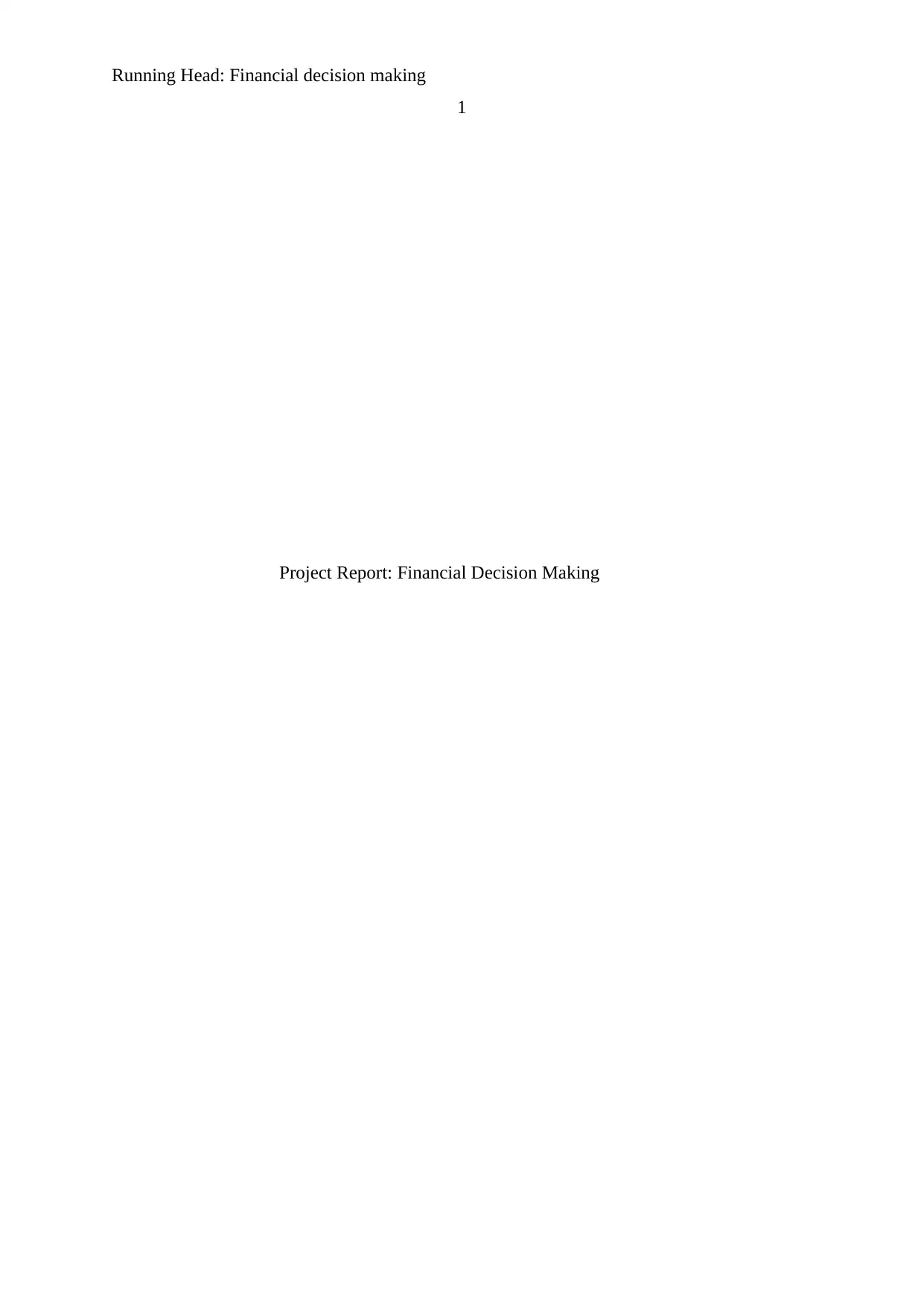
1
Project Report: Financial Decision Making
Paraphrase This Document

2
Contents
Section A:.........................................................................................................................3
Company overview.......................................................................................................3
Horizontal and vertical analysis....................................................................................3
Profit analysis...............................................................................................................3
Financial ratios..............................................................................................................4
Profitability ratios.....................................................................................................4
Dividend ratios..........................................................................................................7
Stability and liquidity ratios....................................................................................10
Efficiency ratios......................................................................................................12
Industry average analysis........................................................................................15
Stock exchange...........................................................................................................17
Comparative analysis..................................................................................................17
Conclusion..................................................................................................................17
Section B.........................................................................................................................19
Motives of acquisition................................................................................................19
Impact on brand and reputation..................................................................................19
Governance report......................................................................................................19
Vision and strategic financial parameters (Conclusion).............................................19
References.......................................................................................................................21
Appendix.........................................................................................................................23
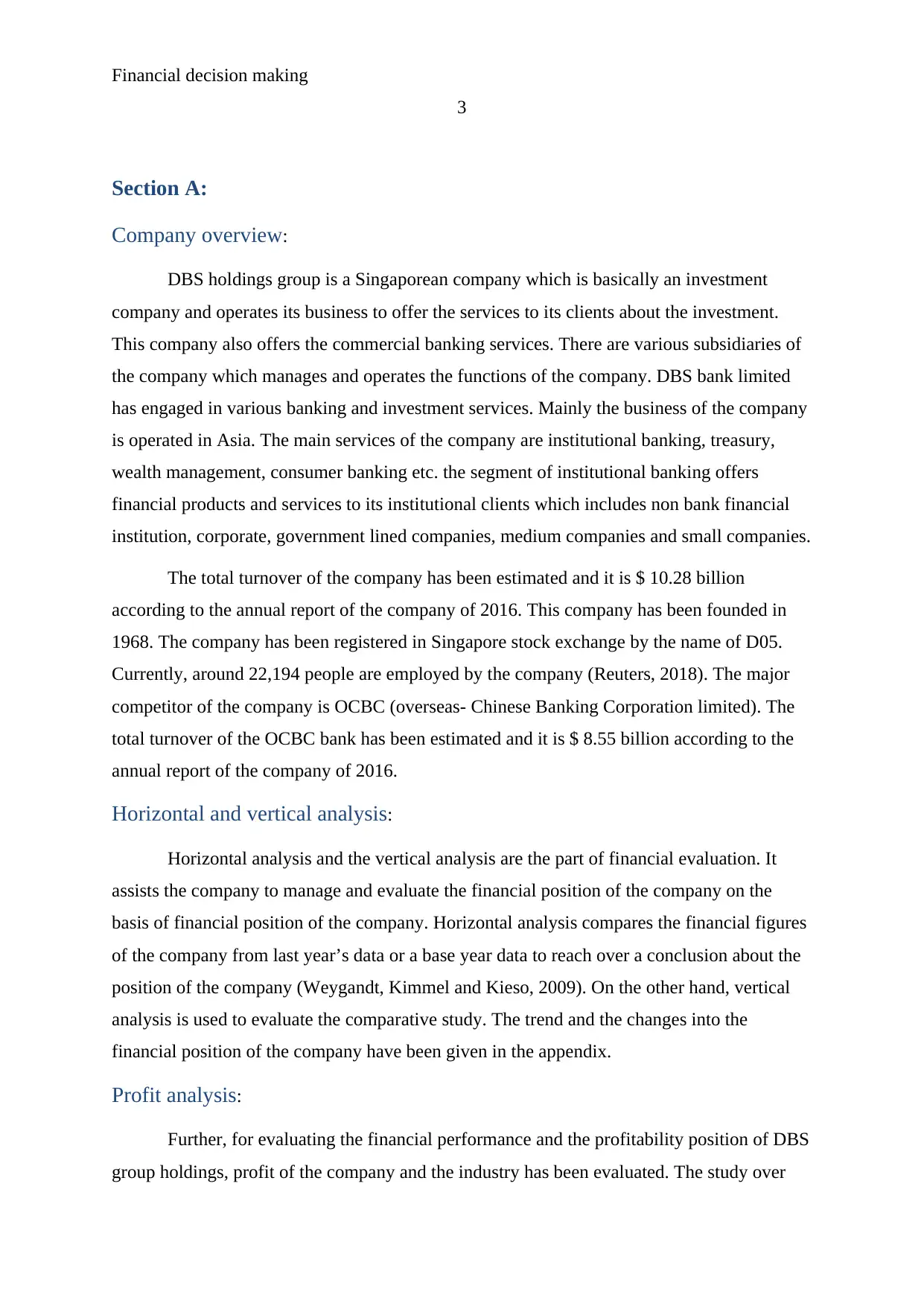
3
Section A:
Company overview:
DBS holdings group is a Singaporean company which is basically an investment
company and operates its business to offer the services to its clients about the investment.
This company also offers the commercial banking services. There are various subsidiaries of
the company which manages and operates the functions of the company. DBS bank limited
has engaged in various banking and investment services. Mainly the business of the company
is operated in Asia. The main services of the company are institutional banking, treasury,
wealth management, consumer banking etc. the segment of institutional banking offers
financial products and services to its institutional clients which includes non bank financial
institution, corporate, government lined companies, medium companies and small companies.
The total turnover of the company has been estimated and it is $ 10.28 billion
according to the annual report of the company of 2016. This company has been founded in
1968. The company has been registered in Singapore stock exchange by the name of D05.
Currently, around 22,194 people are employed by the company (Reuters, 2018). The major
competitor of the company is OCBC (overseas- Chinese Banking Corporation limited). The
total turnover of the OCBC bank has been estimated and it is $ 8.55 billion according to the
annual report of the company of 2016.
Horizontal and vertical analysis:
Horizontal analysis and the vertical analysis are the part of financial evaluation. It
assists the company to manage and evaluate the financial position of the company on the
basis of financial position of the company. Horizontal analysis compares the financial figures
of the company from last year’s data or a base year data to reach over a conclusion about the
position of the company (Weygandt, Kimmel and Kieso, 2009). On the other hand, vertical
analysis is used to evaluate the comparative study. The trend and the changes into the
financial position of the company have been given in the appendix.
Profit analysis:
Further, for evaluating the financial performance and the profitability position of DBS
group holdings, profit of the company and the industry has been evaluated. The study over
⊘ This is a preview!⊘
Do you want full access?
Subscribe today to unlock all pages.

Trusted by 1+ million students worldwide
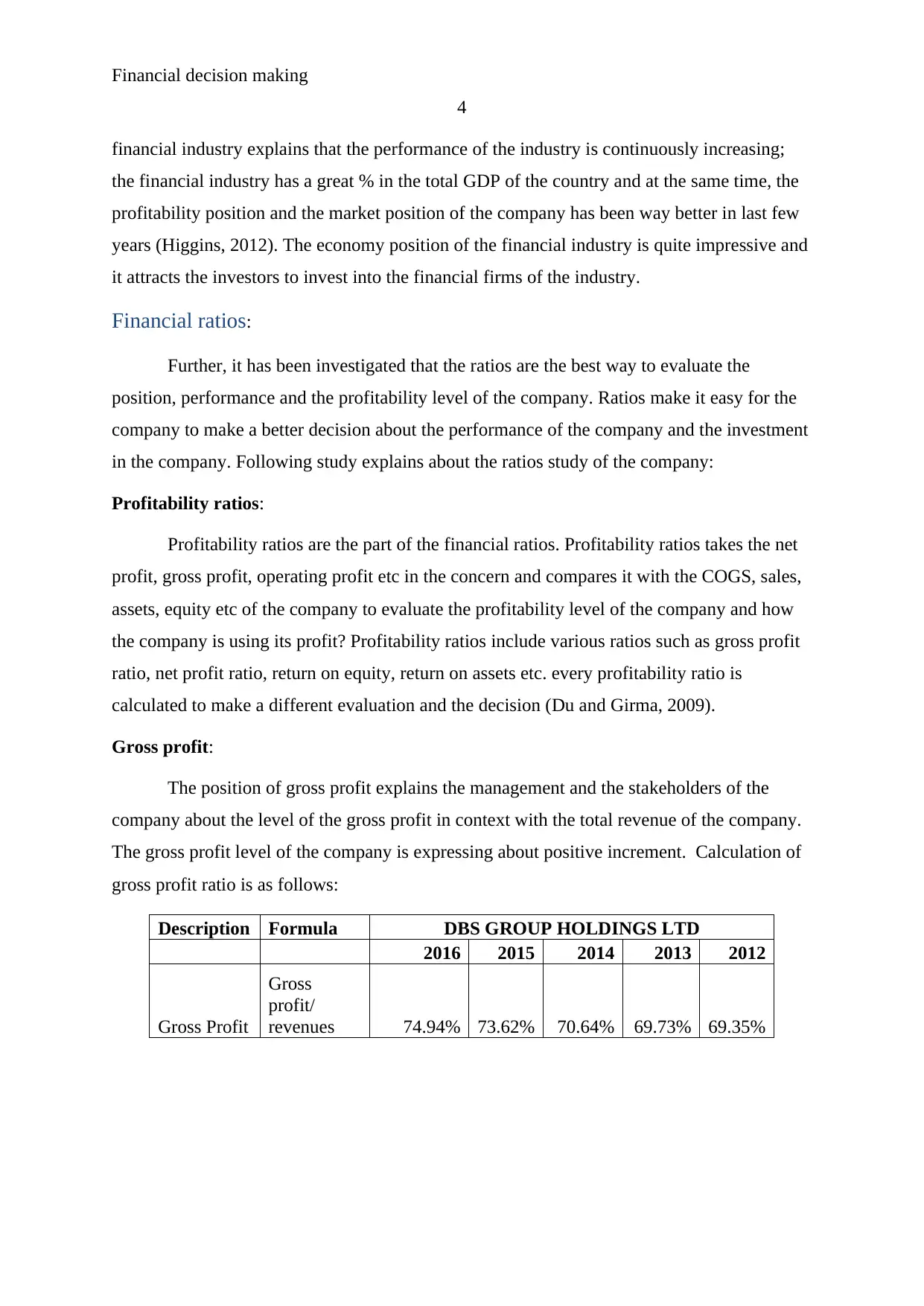
4
financial industry explains that the performance of the industry is continuously increasing;
the financial industry has a great % in the total GDP of the country and at the same time, the
profitability position and the market position of the company has been way better in last few
years (Higgins, 2012). The economy position of the financial industry is quite impressive and
it attracts the investors to invest into the financial firms of the industry.
Financial ratios:
Further, it has been investigated that the ratios are the best way to evaluate the
position, performance and the profitability level of the company. Ratios make it easy for the
company to make a better decision about the performance of the company and the investment
in the company. Following study explains about the ratios study of the company:
Profitability ratios:
Profitability ratios are the part of the financial ratios. Profitability ratios takes the net
profit, gross profit, operating profit etc in the concern and compares it with the COGS, sales,
assets, equity etc of the company to evaluate the profitability level of the company and how
the company is using its profit? Profitability ratios include various ratios such as gross profit
ratio, net profit ratio, return on equity, return on assets etc. every profitability ratio is
calculated to make a different evaluation and the decision (Du and Girma, 2009).
Gross profit:
The position of gross profit explains the management and the stakeholders of the
company about the level of the gross profit in context with the total revenue of the company.
The gross profit level of the company is expressing about positive increment. Calculation of
gross profit ratio is as follows:
Description Formula DBS GROUP HOLDINGS LTD
2016 2015 2014 2013 2012
Gross Profit
Gross
profit/
revenues 74.94% 73.62% 70.64% 69.73% 69.35%
Paraphrase This Document
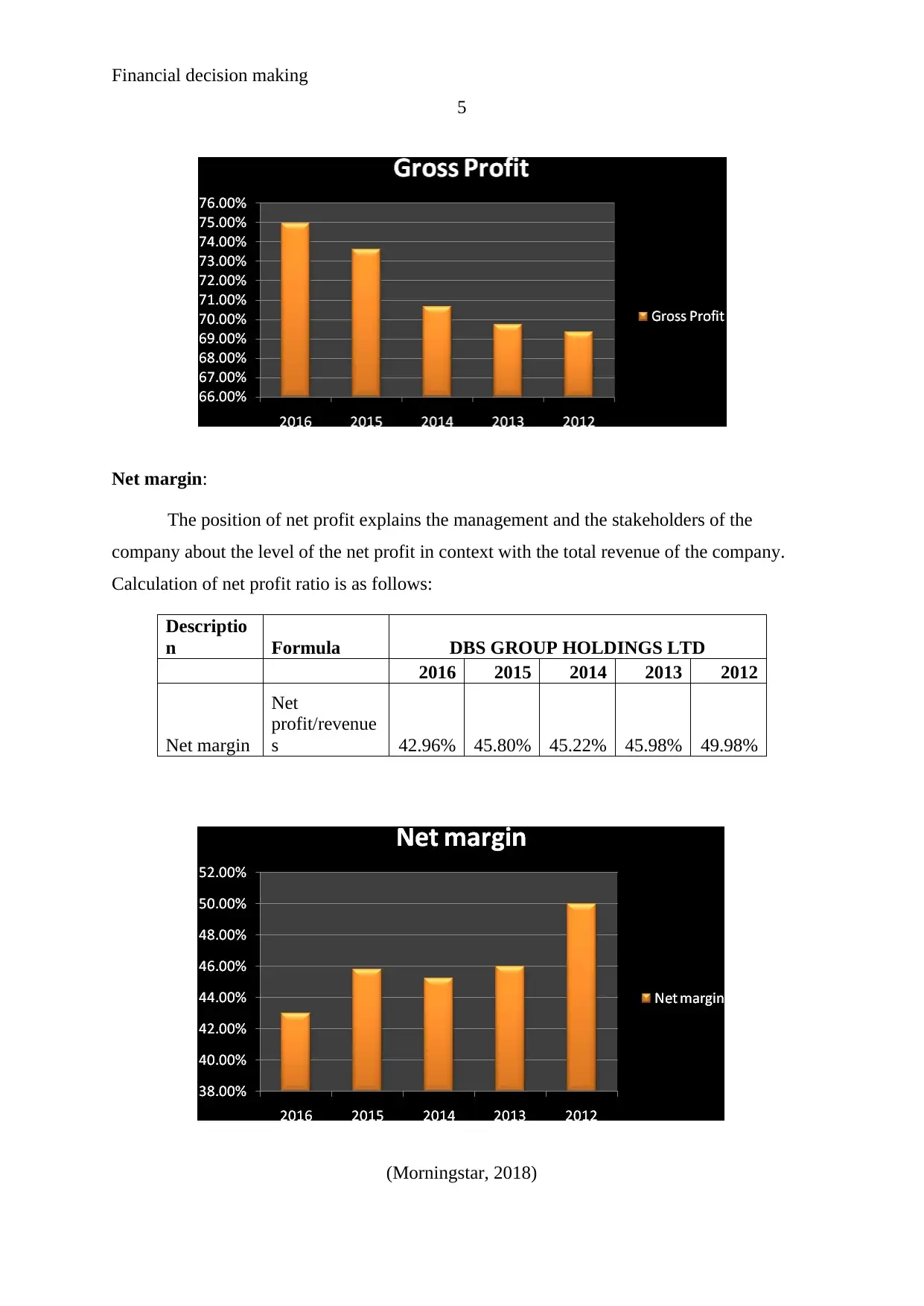
5
Net margin:
The position of net profit explains the management and the stakeholders of the
company about the level of the net profit in context with the total revenue of the company.
Calculation of net profit ratio is as follows:
Descriptio
n Formula DBS GROUP HOLDINGS LTD
2016 2015 2014 2013 2012
Net margin
Net
profit/revenue
s 42.96% 45.80% 45.22% 45.98% 49.98%
(Morningstar, 2018)
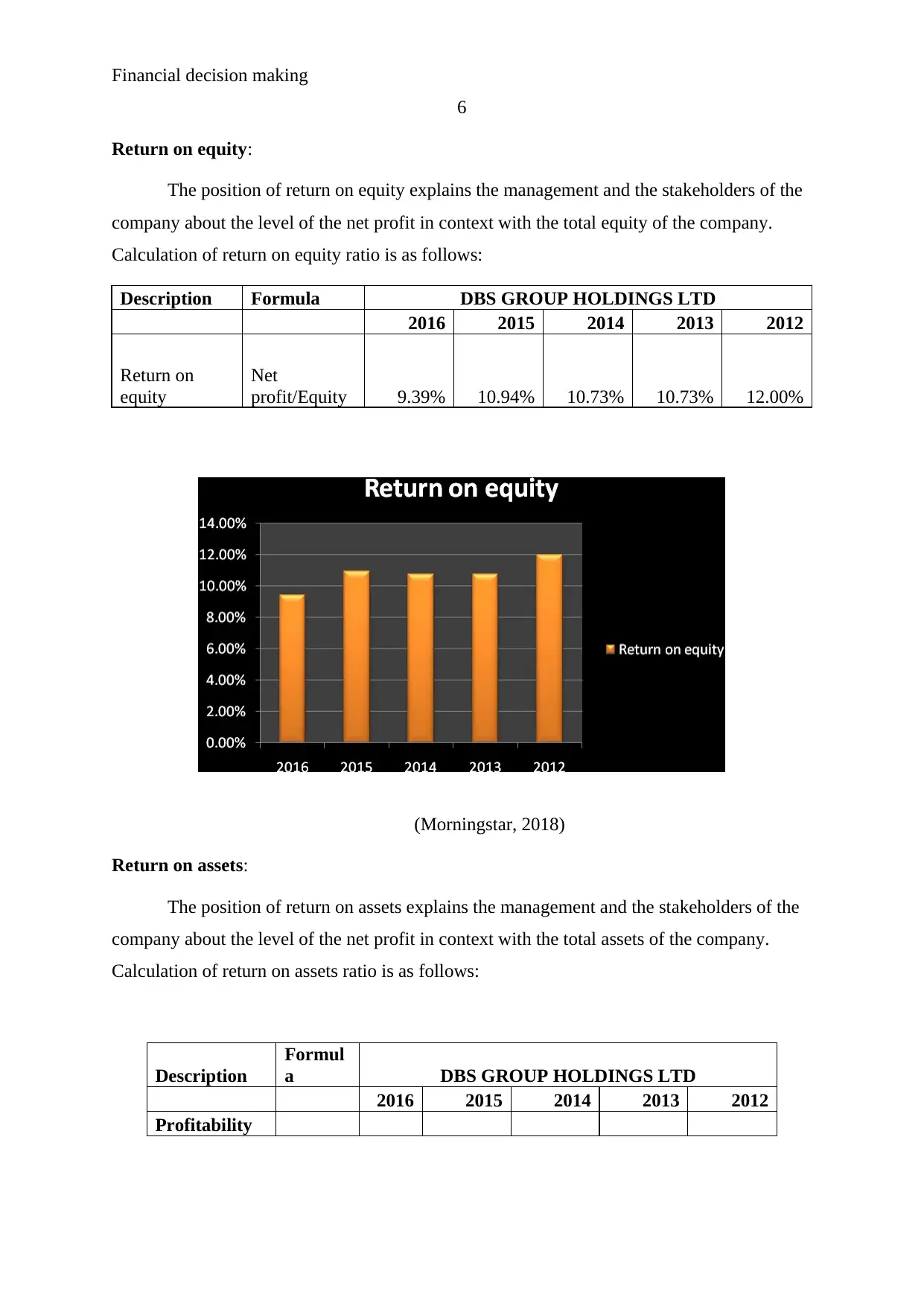
6
Return on equity:
The position of return on equity explains the management and the stakeholders of the
company about the level of the net profit in context with the total equity of the company.
Calculation of return on equity ratio is as follows:
Description Formula DBS GROUP HOLDINGS LTD
2016 2015 2014 2013 2012
Return on
equity
Net
profit/Equity 9.39% 10.94% 10.73% 10.73% 12.00%
(Morningstar, 2018)
Return on assets:
The position of return on assets explains the management and the stakeholders of the
company about the level of the net profit in context with the total assets of the company.
Calculation of return on assets ratio is as follows:
Description
Formul
a DBS GROUP HOLDINGS LTD
2016 2015 2014 2013 2012
Profitability
⊘ This is a preview!⊘
Do you want full access?
Subscribe today to unlock all pages.

Trusted by 1+ million students worldwide

7
Return on
assets
Net
income/
Total
assets
0.87
% 0.96% 0.92% 0.91% 1.08%
Dividend ratios:
Dividend ratios are the part of the financial ratios. Dividend ratios takes the net profit,
dividend, outstanding shares, price per share, market value etc in the concern to evaluate the
dividend level of the company.
Dividend yield:
The position of dividend yield explains the management and the stakeholders of the
company about the level of the dividend in context with the stock price of the company.
Calculation of dividend yield ratio is as follows:
Description Formula DBS GROUP HOLDINGS LTD
2016 2015 2014 2013 2012
Dividend yield
ratios
Annual
dividend per
share/ price
per share 17.27% 16.81% 15.32% 15.96% 16.25%
(Morningstar, 2018)
Paraphrase This Document
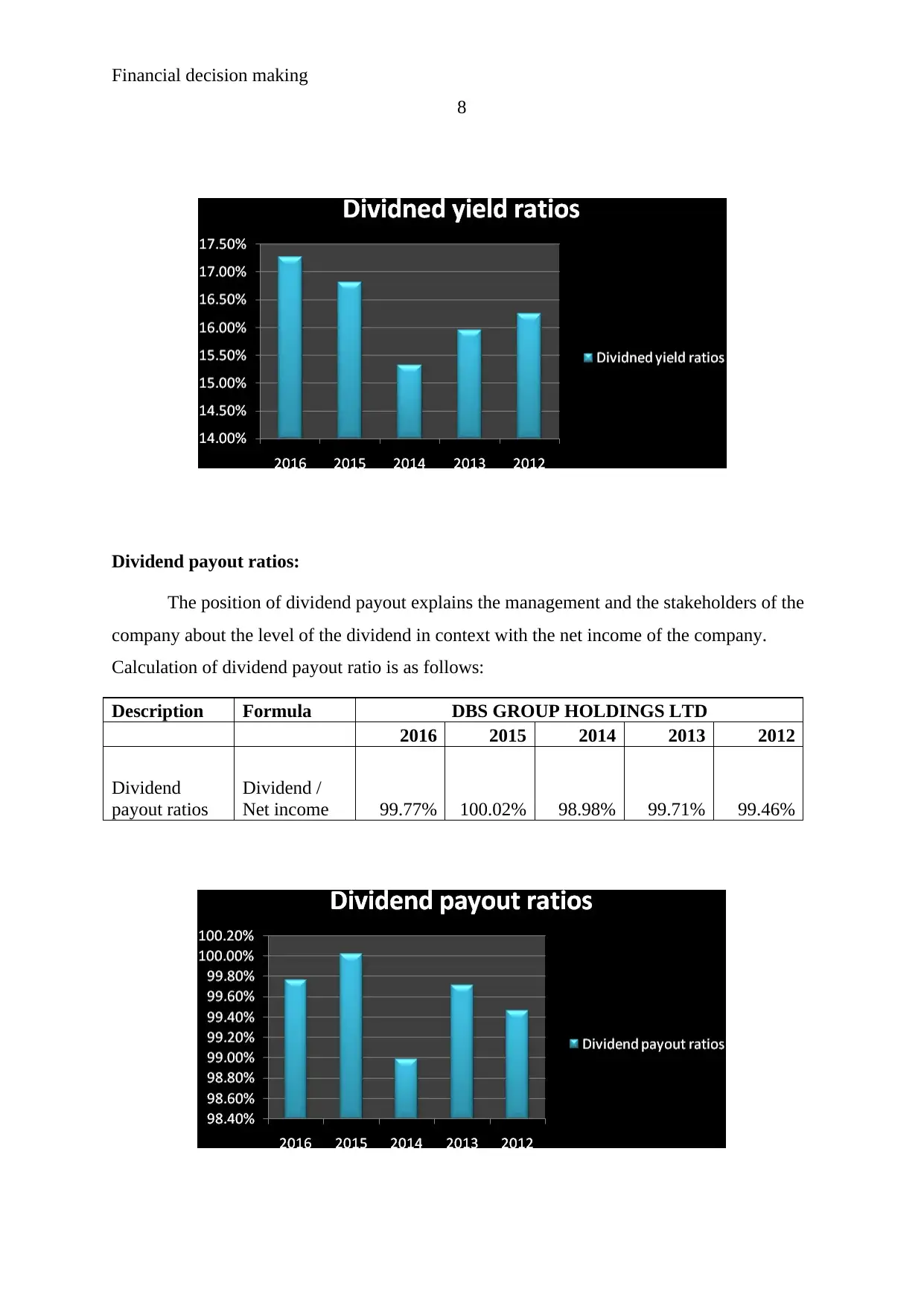
8
Dividend payout ratios:
The position of dividend payout explains the management and the stakeholders of the
company about the level of the dividend in context with the net income of the company.
Calculation of dividend payout ratio is as follows:
Description Formula DBS GROUP HOLDINGS LTD
2016 2015 2014 2013 2012
Dividend
payout ratios
Dividend /
Net income 99.77% 100.02% 98.98% 99.71% 99.46%
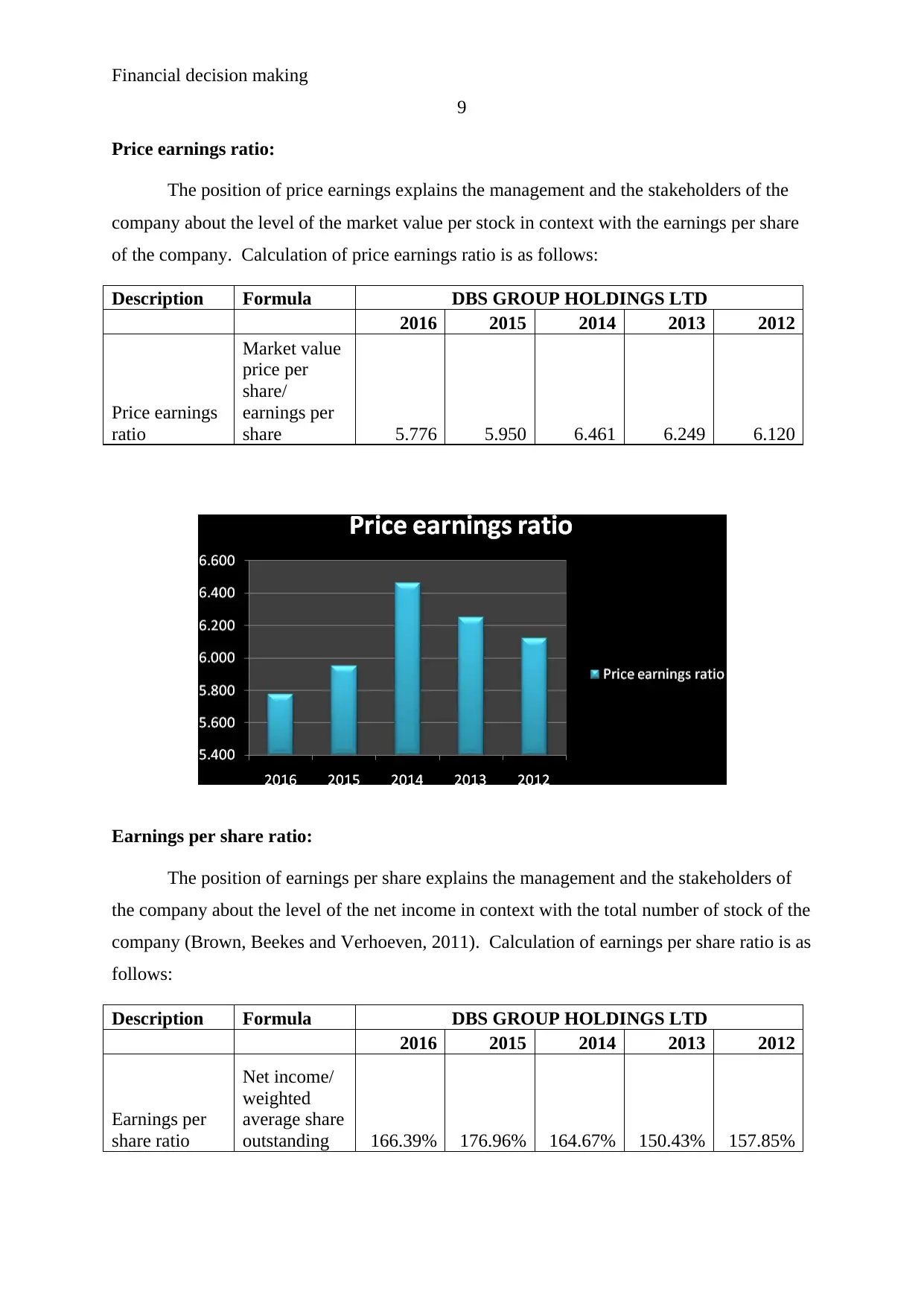
9
Price earnings ratio:
The position of price earnings explains the management and the stakeholders of the
company about the level of the market value per stock in context with the earnings per share
of the company. Calculation of price earnings ratio is as follows:
Description Formula DBS GROUP HOLDINGS LTD
2016 2015 2014 2013 2012
Price earnings
ratio
Market value
price per
share/
earnings per
share 5.776 5.950 6.461 6.249 6.120
Earnings per share ratio:
The position of earnings per share explains the management and the stakeholders of
the company about the level of the net income in context with the total number of stock of the
company (Brown, Beekes and Verhoeven, 2011). Calculation of earnings per share ratio is as
follows:
Description Formula DBS GROUP HOLDINGS LTD
2016 2015 2014 2013 2012
Earnings per
share ratio
Net income/
weighted
average share
outstanding 166.39% 176.96% 164.67% 150.43% 157.85%
⊘ This is a preview!⊘
Do you want full access?
Subscribe today to unlock all pages.

Trusted by 1+ million students worldwide
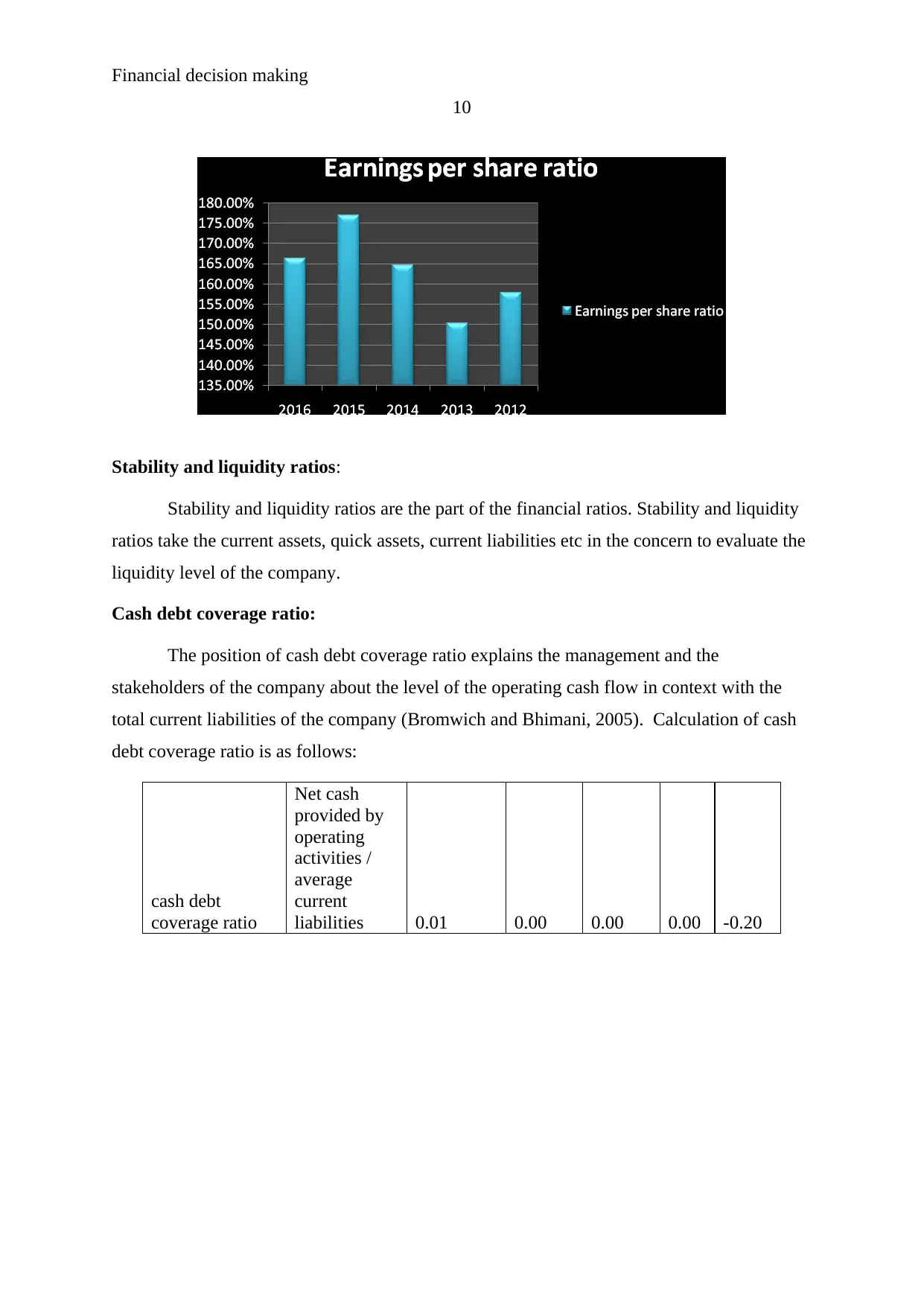
10
Stability and liquidity ratios:
Stability and liquidity ratios are the part of the financial ratios. Stability and liquidity
ratios take the current assets, quick assets, current liabilities etc in the concern to evaluate the
liquidity level of the company.
Cash debt coverage ratio:
The position of cash debt coverage ratio explains the management and the
stakeholders of the company about the level of the operating cash flow in context with the
total current liabilities of the company (Bromwich and Bhimani, 2005). Calculation of cash
debt coverage ratio is as follows:
cash debt
coverage ratio
Net cash
provided by
operating
activities /
average
current
liabilities 0.01 0.00 0.00 0.00 -0.20
Paraphrase This Document
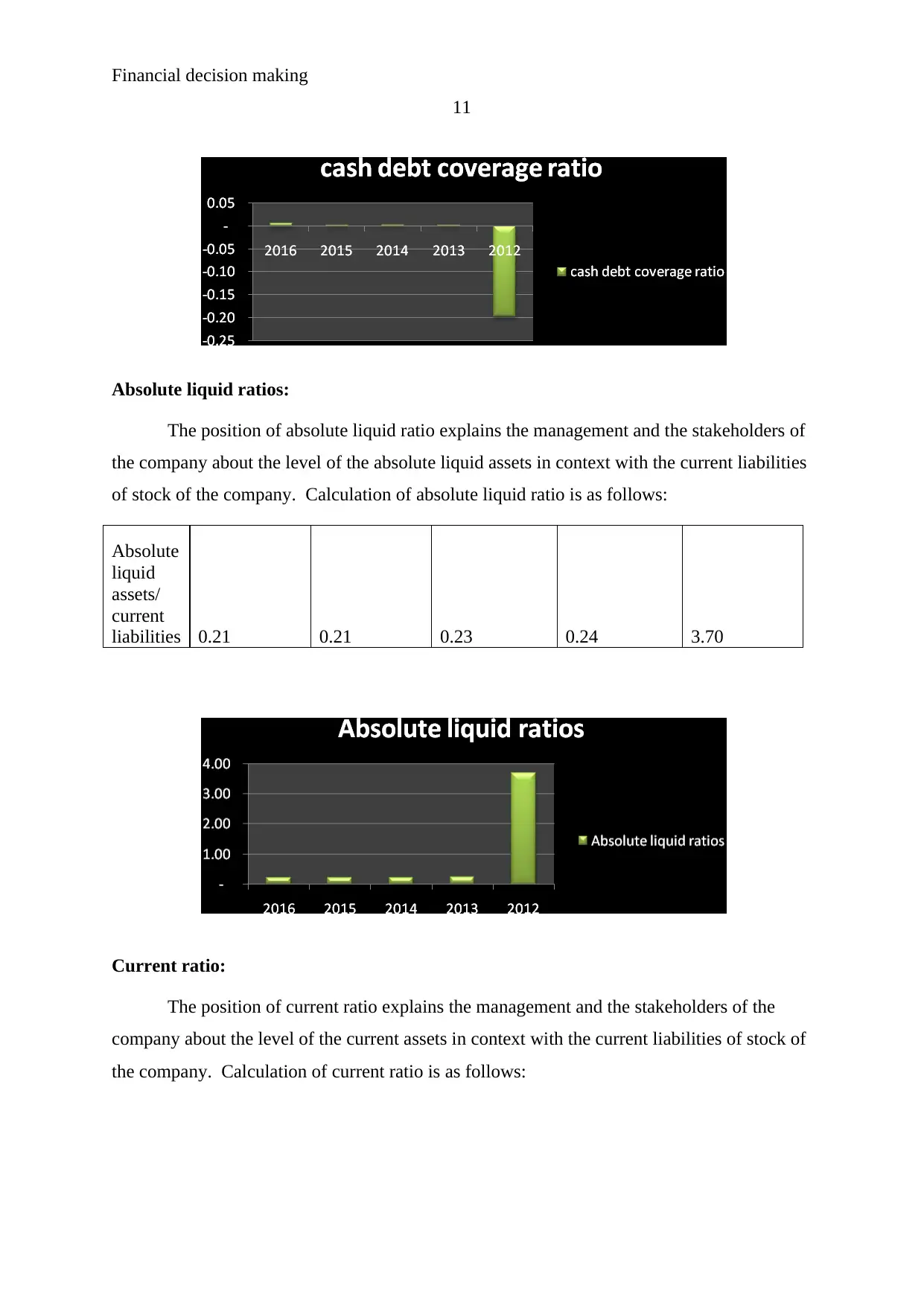
11
Absolute liquid ratios:
The position of absolute liquid ratio explains the management and the stakeholders of
the company about the level of the absolute liquid assets in context with the current liabilities
of stock of the company. Calculation of absolute liquid ratio is as follows:
Absolute
liquid
assets/
current
liabilities 0.21 0.21 0.23 0.24 3.70
Current ratio:
The position of current ratio explains the management and the stakeholders of the
company about the level of the current assets in context with the current liabilities of stock of
the company. Calculation of current ratio is as follows:
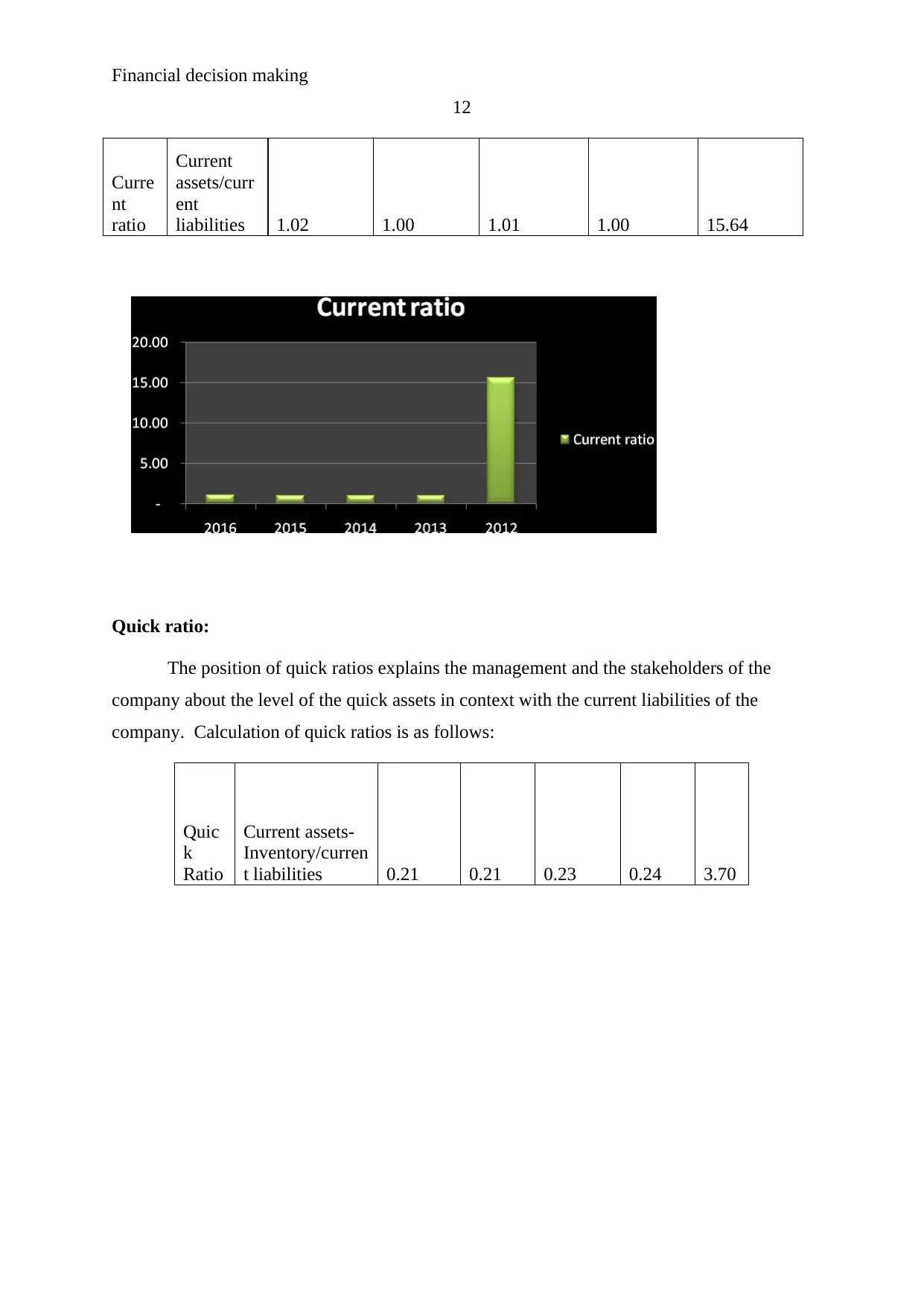
12
Curre
nt
ratio
Current
assets/curr
ent
liabilities 1.02 1.00 1.01 1.00 15.64
Quick ratio:
The position of quick ratios explains the management and the stakeholders of the
company about the level of the quick assets in context with the current liabilities of the
company. Calculation of quick ratios is as follows:
Quic
k
Ratio
Current assets-
Inventory/curren
t liabilities 0.21 0.21 0.23 0.24 3.70
⊘ This is a preview!⊘
Do you want full access?
Subscribe today to unlock all pages.

Trusted by 1+ million students worldwide
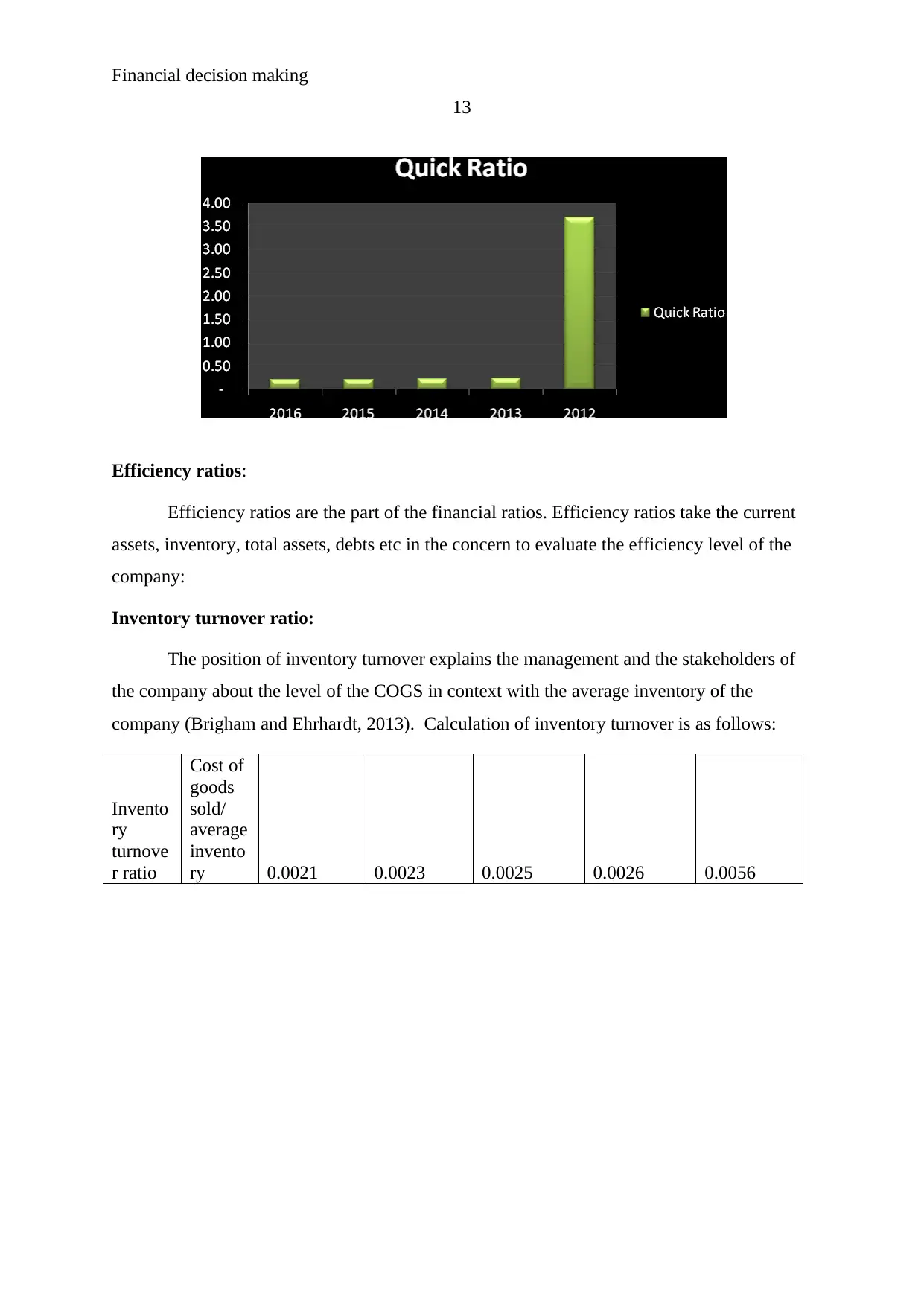
13
Efficiency ratios:
Efficiency ratios are the part of the financial ratios. Efficiency ratios take the current
assets, inventory, total assets, debts etc in the concern to evaluate the efficiency level of the
company:
Inventory turnover ratio:
The position of inventory turnover explains the management and the stakeholders of
the company about the level of the COGS in context with the average inventory of the
company (Brigham and Ehrhardt, 2013). Calculation of inventory turnover is as follows:
Invento
ry
turnove
r ratio
Cost of
goods
sold/
average
invento
ry 0.0021 0.0023 0.0025 0.0026 0.0056
Paraphrase This Document
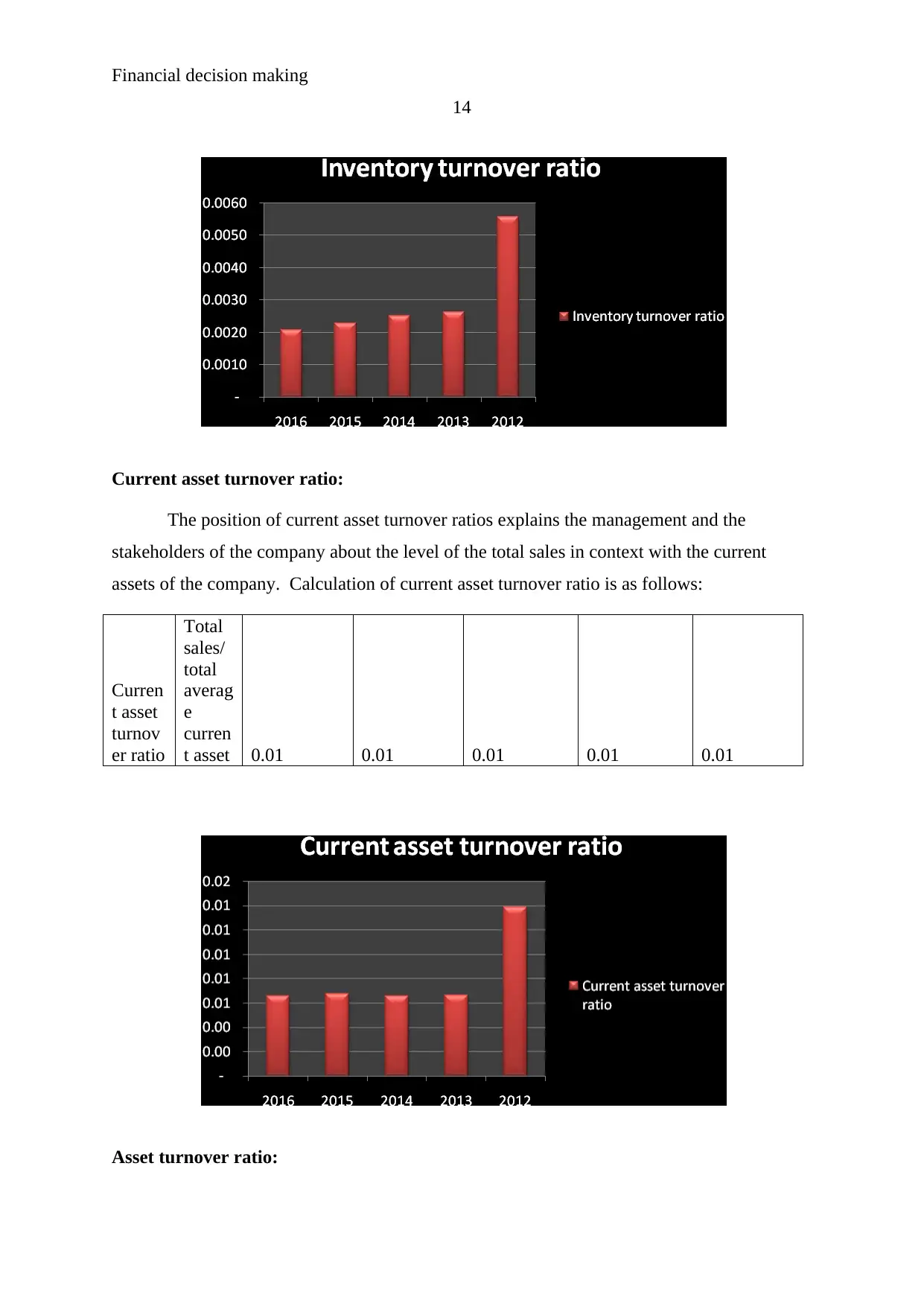
14
Current asset turnover ratio:
The position of current asset turnover ratios explains the management and the
stakeholders of the company about the level of the total sales in context with the current
assets of the company. Calculation of current asset turnover ratio is as follows:
Curren
t asset
turnov
er ratio
Total
sales/
total
averag
e
curren
t asset 0.01 0.01 0.01 0.01 0.01
Asset turnover ratio:

15
The position of asset turnover explains the management and the stakeholders of the
company about the level of the total sales in context with the total assets of the company.
Calculation of asset turnover ratios is as follows:
Asset
turnov
er ratio
Total
sales/
Avera
ge
Total
assets 0.01 0.01 0.01 0.01 0.01
Debtor’s turnover ratio:
The position of quick ratios explains the management and the stakeholders of the
company about the level of the quick assets in context with the current liabilities of the
company. Calculation of quick ratios is as follows:
Debtor
's
turnov
er
ratio
Net
credit
sales/
Average
accounti
ng
receivabl
es 0.07 0.06 0.05 0.06 0.13
⊘ This is a preview!⊘
Do you want full access?
Subscribe today to unlock all pages.

Trusted by 1+ million students worldwide
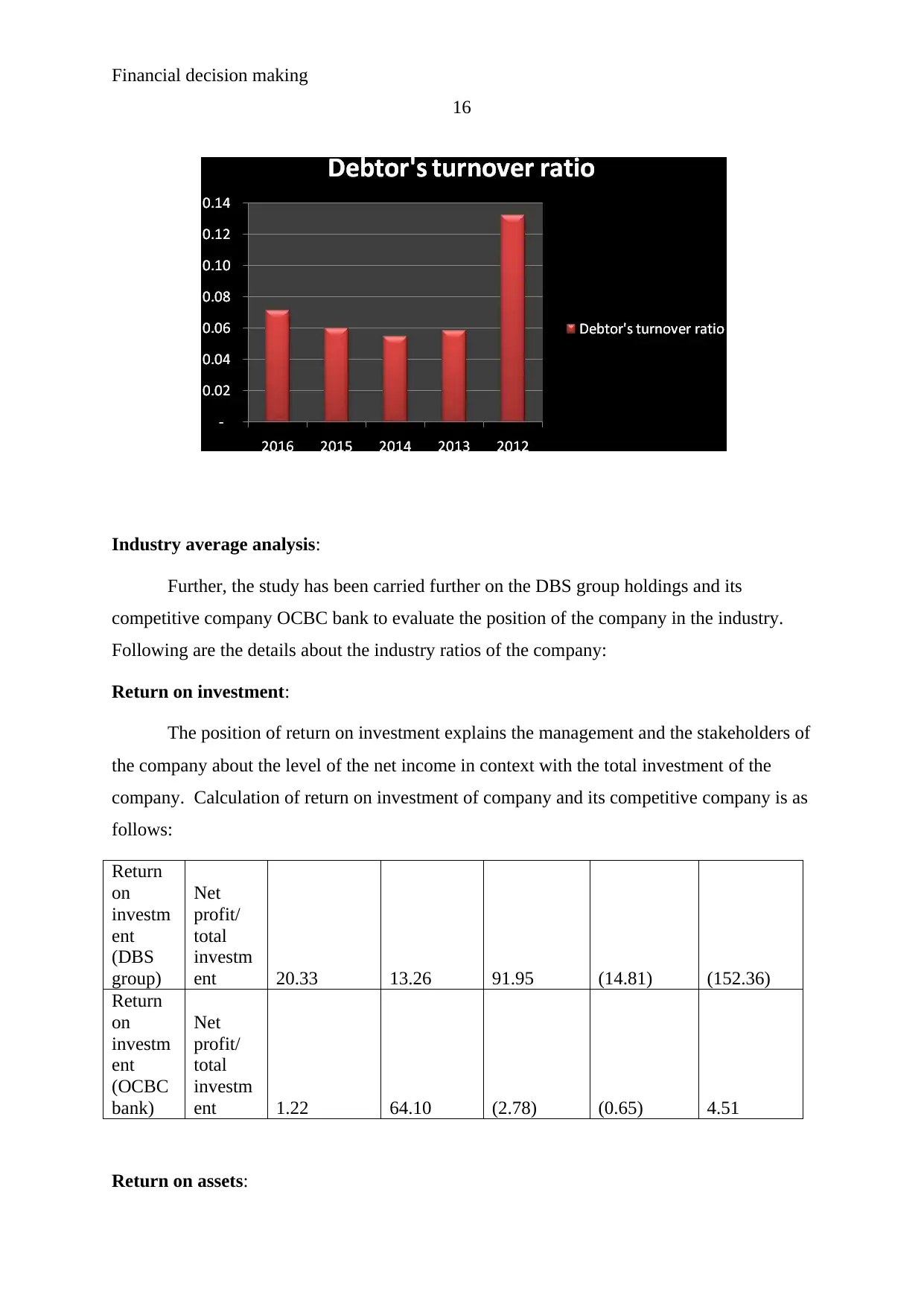
16
Industry average analysis:
Further, the study has been carried further on the DBS group holdings and its
competitive company OCBC bank to evaluate the position of the company in the industry.
Following are the details about the industry ratios of the company:
Return on investment:
The position of return on investment explains the management and the stakeholders of
the company about the level of the net income in context with the total investment of the
company. Calculation of return on investment of company and its competitive company is as
follows:
Return
on
investm
ent
(DBS
group)
Net
profit/
total
investm
ent 20.33 13.26 91.95 (14.81) (152.36)
Return
on
investm
ent
(OCBC
bank)
Net
profit/
total
investm
ent 1.22 64.10 (2.78) (0.65) 4.51
Return on assets:
Paraphrase This Document
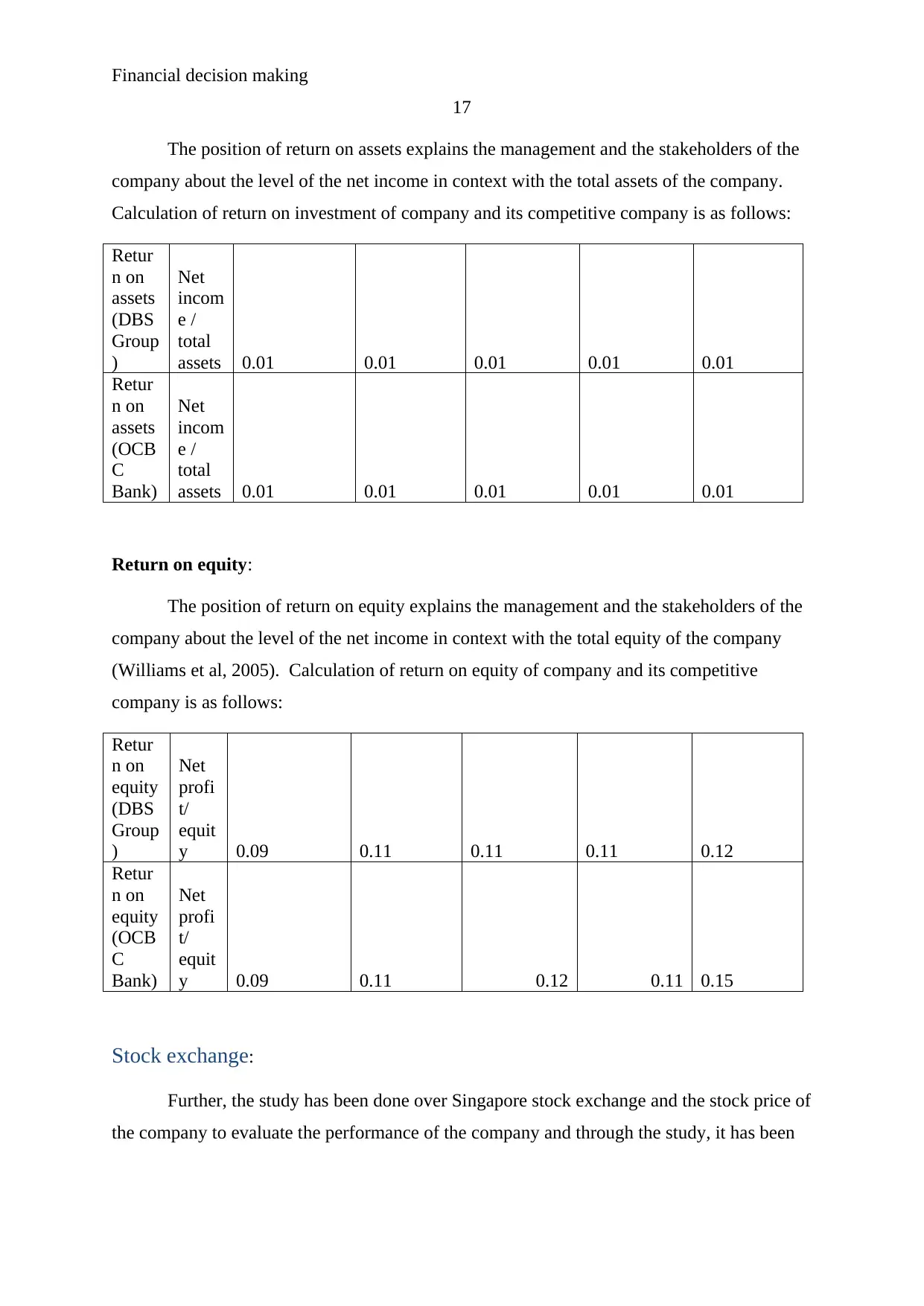
17
The position of return on assets explains the management and the stakeholders of the
company about the level of the net income in context with the total assets of the company.
Calculation of return on investment of company and its competitive company is as follows:
Retur
n on
assets
(DBS
Group
)
Net
incom
e /
total
assets 0.01 0.01 0.01 0.01 0.01
Retur
n on
assets
(OCB
C
Bank)
Net
incom
e /
total
assets 0.01 0.01 0.01 0.01 0.01
Return on equity:
The position of return on equity explains the management and the stakeholders of the
company about the level of the net income in context with the total equity of the company
(Williams et al, 2005). Calculation of return on equity of company and its competitive
company is as follows:
Retur
n on
equity
(DBS
Group
)
Net
profi
t/
equit
y 0.09 0.11 0.11 0.11 0.12
Retur
n on
equity
(OCB
C
Bank)
Net
profi
t/
equit
y 0.09 0.11 0.12 0.11 0.15
Stock exchange:
Further, the study has been done over Singapore stock exchange and the stock price of
the company to evaluate the performance of the company and through the study, it has been
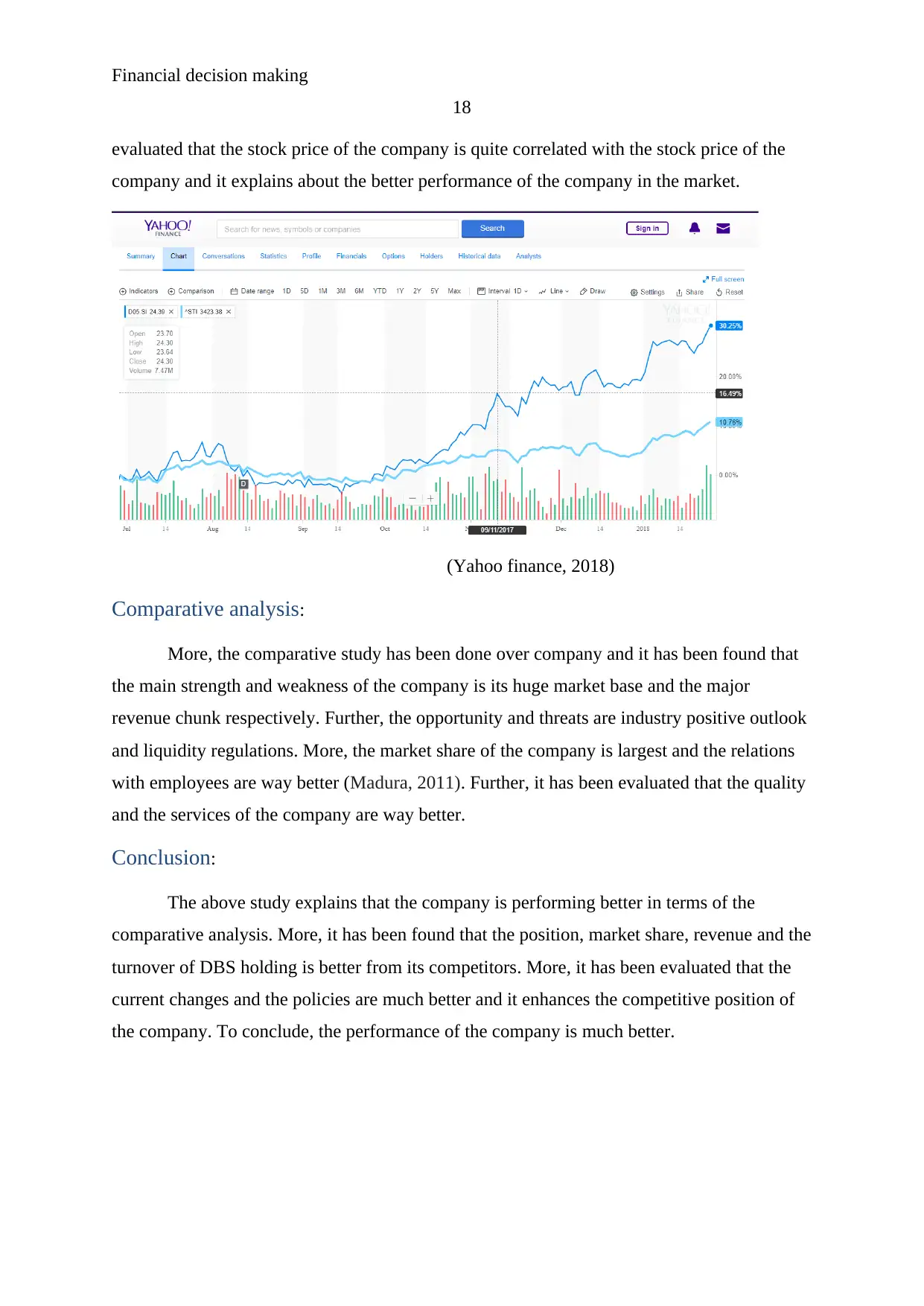
18
evaluated that the stock price of the company is quite correlated with the stock price of the
company and it explains about the better performance of the company in the market.
(Yahoo finance, 2018)
Comparative analysis:
More, the comparative study has been done over company and it has been found that
the main strength and weakness of the company is its huge market base and the major
revenue chunk respectively. Further, the opportunity and threats are industry positive outlook
and liquidity regulations. More, the market share of the company is largest and the relations
with employees are way better (Madura, 2011). Further, it has been evaluated that the quality
and the services of the company are way better.
Conclusion:
The above study explains that the company is performing better in terms of the
comparative analysis. More, it has been found that the position, market share, revenue and the
turnover of DBS holding is better from its competitors. More, it has been evaluated that the
current changes and the policies are much better and it enhances the competitive position of
the company. To conclude, the performance of the company is much better.
⊘ This is a preview!⊘
Do you want full access?
Subscribe today to unlock all pages.

Trusted by 1+ million students worldwide
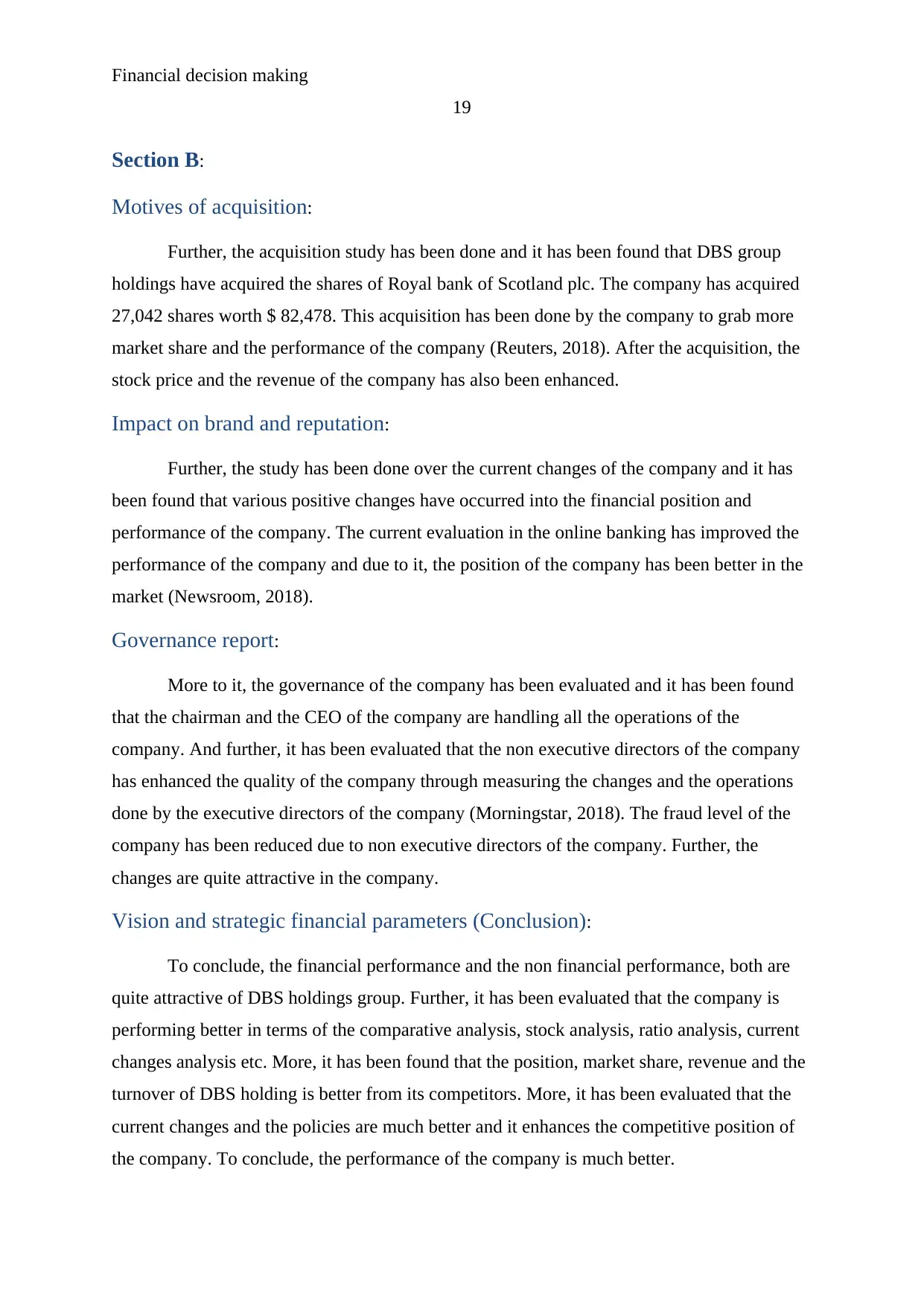
19
Section B:
Motives of acquisition:
Further, the acquisition study has been done and it has been found that DBS group
holdings have acquired the shares of Royal bank of Scotland plc. The company has acquired
27,042 shares worth $ 82,478. This acquisition has been done by the company to grab more
market share and the performance of the company (Reuters, 2018). After the acquisition, the
stock price and the revenue of the company has also been enhanced.
Impact on brand and reputation:
Further, the study has been done over the current changes of the company and it has
been found that various positive changes have occurred into the financial position and
performance of the company. The current evaluation in the online banking has improved the
performance of the company and due to it, the position of the company has been better in the
market (Newsroom, 2018).
Governance report:
More to it, the governance of the company has been evaluated and it has been found
that the chairman and the CEO of the company are handling all the operations of the
company. And further, it has been evaluated that the non executive directors of the company
has enhanced the quality of the company through measuring the changes and the operations
done by the executive directors of the company (Morningstar, 2018). The fraud level of the
company has been reduced due to non executive directors of the company. Further, the
changes are quite attractive in the company.
Vision and strategic financial parameters (Conclusion):
To conclude, the financial performance and the non financial performance, both are
quite attractive of DBS holdings group. Further, it has been evaluated that the company is
performing better in terms of the comparative analysis, stock analysis, ratio analysis, current
changes analysis etc. More, it has been found that the position, market share, revenue and the
turnover of DBS holding is better from its competitors. More, it has been evaluated that the
current changes and the policies are much better and it enhances the competitive position of
the company. To conclude, the performance of the company is much better.
Paraphrase This Document

20
These changes explains that user and the investor that it is a good option in the
financial industry of Singapore to invest as it would offer huge return to the company and the
dividends of the company are also good. Further, it explains that the stock price of the
company is also increasing continuously. To conclude, this company is a good option for the
purpose of investment.
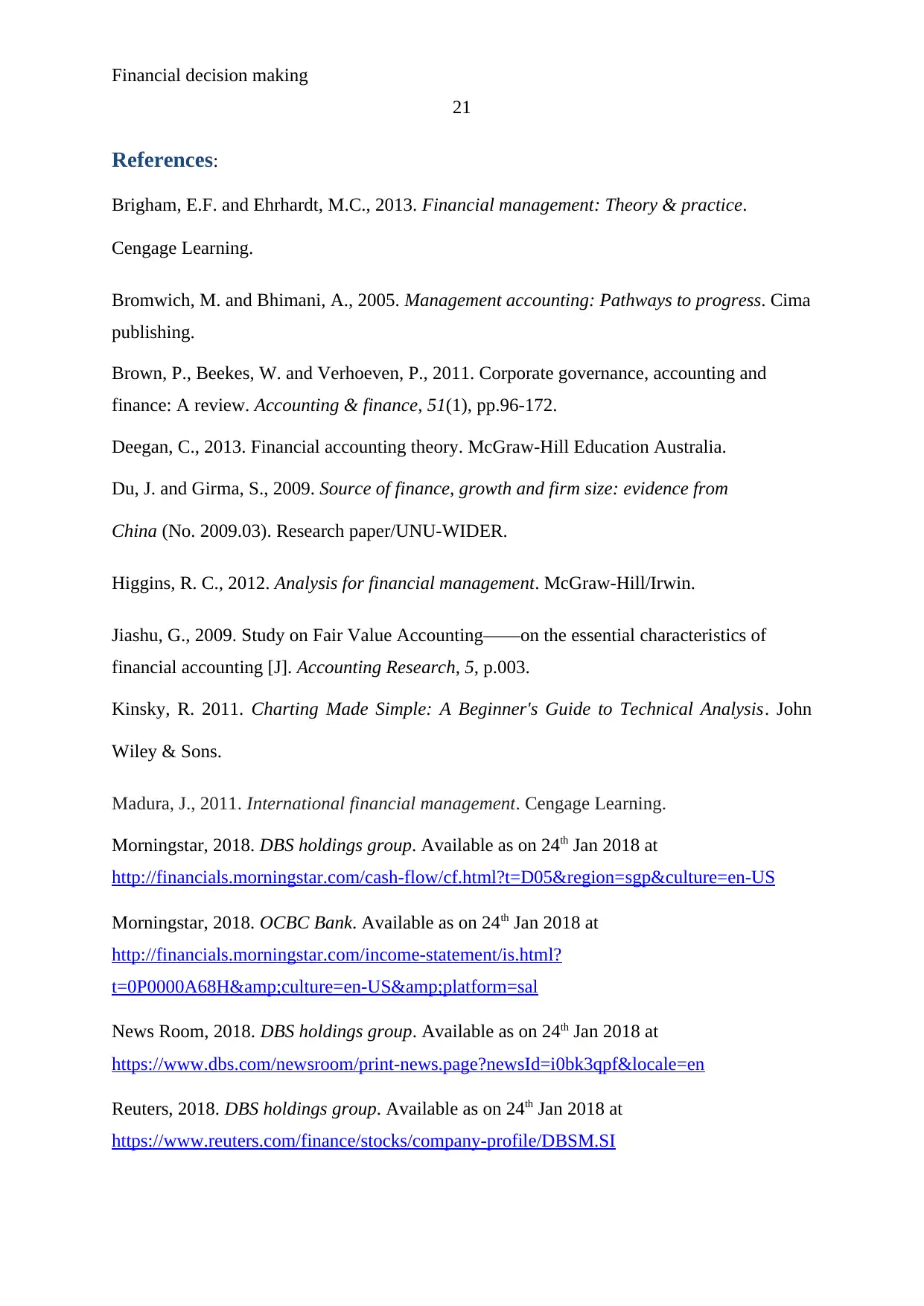
21
References:
Brigham, E.F. and Ehrhardt, M.C., 2013. Financial management: Theory & practice.
Cengage Learning.
Bromwich, M. and Bhimani, A., 2005. Management accounting: Pathways to progress. Cima
publishing.
Brown, P., Beekes, W. and Verhoeven, P., 2011. Corporate governance, accounting and
finance: A review. Accounting & finance, 51(1), pp.96-172.
Deegan, C., 2013. Financial accounting theory. McGraw-Hill Education Australia.
Du, J. and Girma, S., 2009. Source of finance, growth and firm size: evidence from
China (No. 2009.03). Research paper/UNU-WIDER.
Higgins, R. C., 2012. Analysis for financial management. McGraw-Hill/Irwin.
Jiashu, G., 2009. Study on Fair Value Accounting——on the essential characteristics of
financial accounting [J]. Accounting Research, 5, p.003.
Kinsky, R. 2011. Charting Made Simple: A Beginner's Guide to Technical Analysis. John
Wiley & Sons.
Madura, J., 2011. International financial management. Cengage Learning.
Morningstar, 2018. DBS holdings group. Available as on 24th Jan 2018 at
http://financials.morningstar.com/cash-flow/cf.html?t=D05®ion=sgp&culture=en-US
Morningstar, 2018. OCBC Bank. Available as on 24th Jan 2018 at
http://financials.morningstar.com/income-statement/is.html?
t=0P0000A68H&culture=en-US&platform=sal
News Room, 2018. DBS holdings group. Available as on 24th Jan 2018 at
https://www.dbs.com/newsroom/print-news.page?newsId=i0bk3qpf&locale=en
Reuters, 2018. DBS holdings group. Available as on 24th Jan 2018 at
https://www.reuters.com/finance/stocks/company-profile/DBSM.SI
⊘ This is a preview!⊘
Do you want full access?
Subscribe today to unlock all pages.

Trusted by 1+ million students worldwide
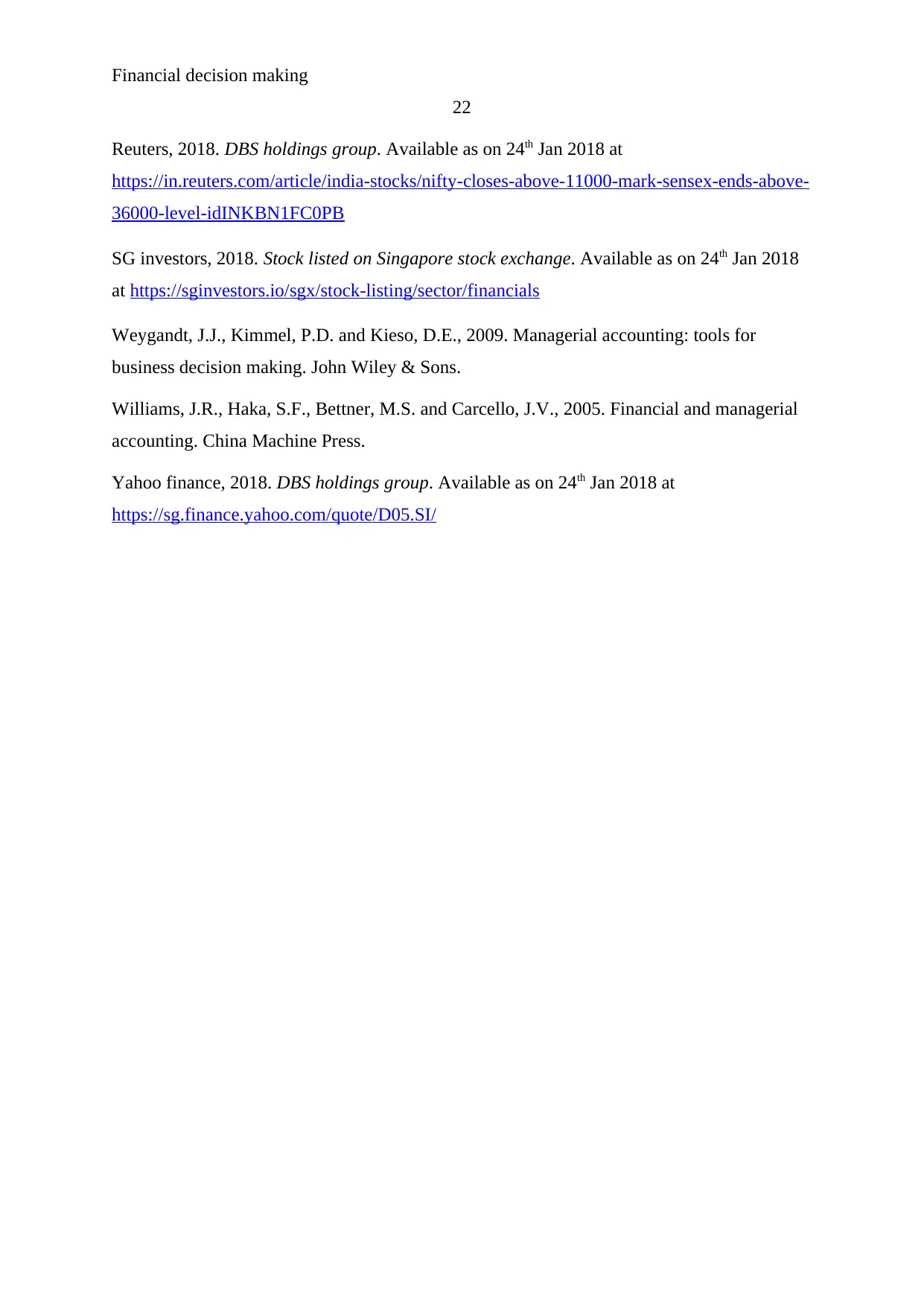
22
Reuters, 2018. DBS holdings group. Available as on 24th Jan 2018 at
https://in.reuters.com/article/india-stocks/nifty-closes-above-11000-mark-sensex-ends-above-
36000-level-idINKBN1FC0PB
SG investors, 2018. Stock listed on Singapore stock exchange. Available as on 24th Jan 2018
at https://sginvestors.io/sgx/stock-listing/sector/financials
Weygandt, J.J., Kimmel, P.D. and Kieso, D.E., 2009. Managerial accounting: tools for
business decision making. John Wiley & Sons.
Williams, J.R., Haka, S.F., Bettner, M.S. and Carcello, J.V., 2005. Financial and managerial
accounting. China Machine Press.
Yahoo finance, 2018. DBS holdings group. Available as on 24th Jan 2018 at
https://sg.finance.yahoo.com/quote/D05.SI/
Paraphrase This Document
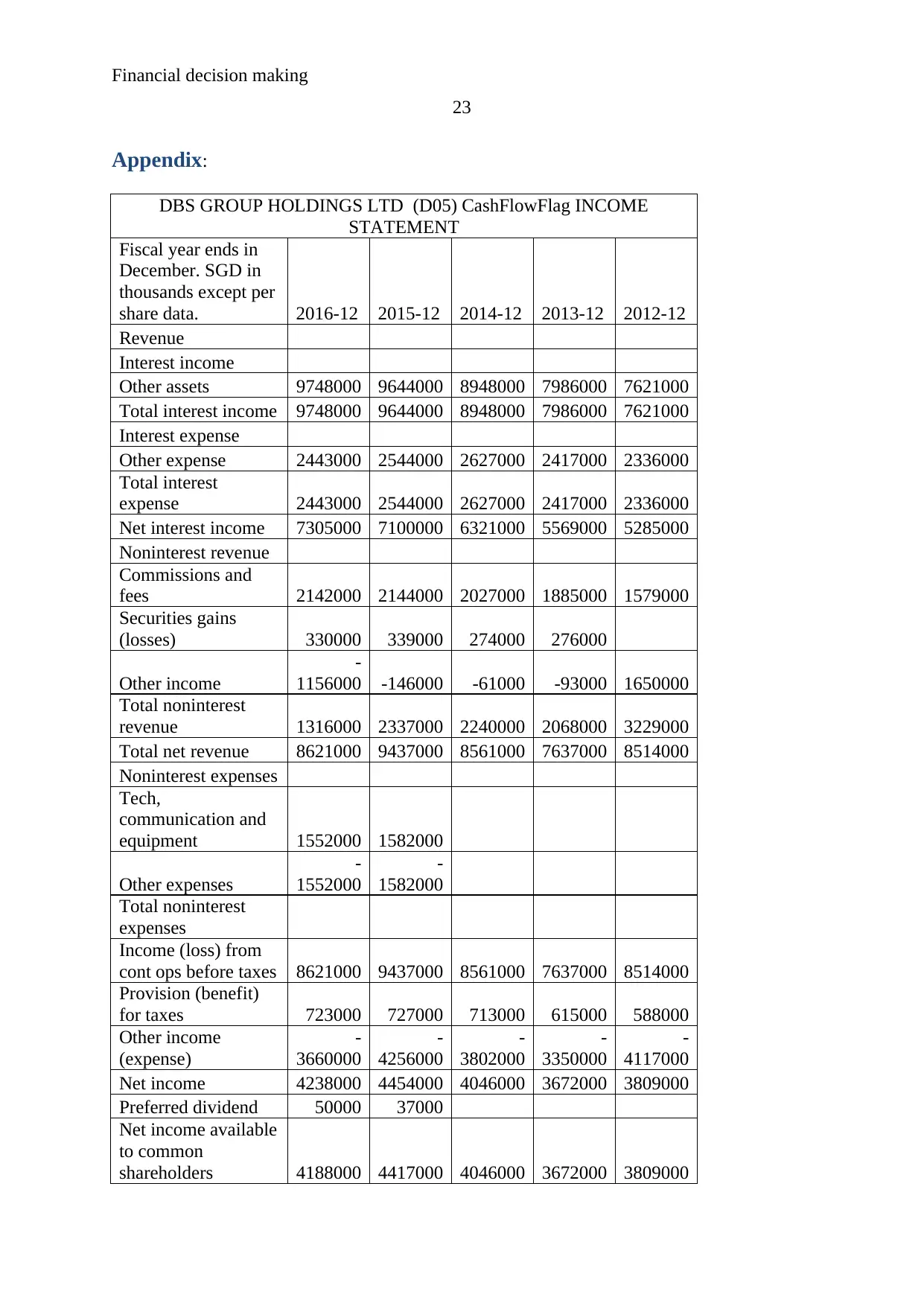
23
Appendix:
DBS GROUP HOLDINGS LTD (D05) CashFlowFlag INCOME
STATEMENT
Fiscal year ends in
December. SGD in
thousands except per
share data. 2016-12 2015-12 2014-12 2013-12 2012-12
Revenue
Interest income
Other assets 9748000 9644000 8948000 7986000 7621000
Total interest income 9748000 9644000 8948000 7986000 7621000
Interest expense
Other expense 2443000 2544000 2627000 2417000 2336000
Total interest
expense 2443000 2544000 2627000 2417000 2336000
Net interest income 7305000 7100000 6321000 5569000 5285000
Noninterest revenue
Commissions and
fees 2142000 2144000 2027000 1885000 1579000
Securities gains
(losses) 330000 339000 274000 276000
Other income
-
1156000 -146000 -61000 -93000 1650000
Total noninterest
revenue 1316000 2337000 2240000 2068000 3229000
Total net revenue 8621000 9437000 8561000 7637000 8514000
Noninterest expenses
Tech,
communication and
equipment 1552000 1582000
Other expenses
-
1552000
-
1582000
Total noninterest
expenses
Income (loss) from
cont ops before taxes 8621000 9437000 8561000 7637000 8514000
Provision (benefit)
for taxes 723000 727000 713000 615000 588000
Other income
(expense)
-
3660000
-
4256000
-
3802000
-
3350000
-
4117000
Net income 4238000 4454000 4046000 3672000 3809000
Preferred dividend 50000 37000
Net income available
to common
shareholders 4188000 4417000 4046000 3672000 3809000
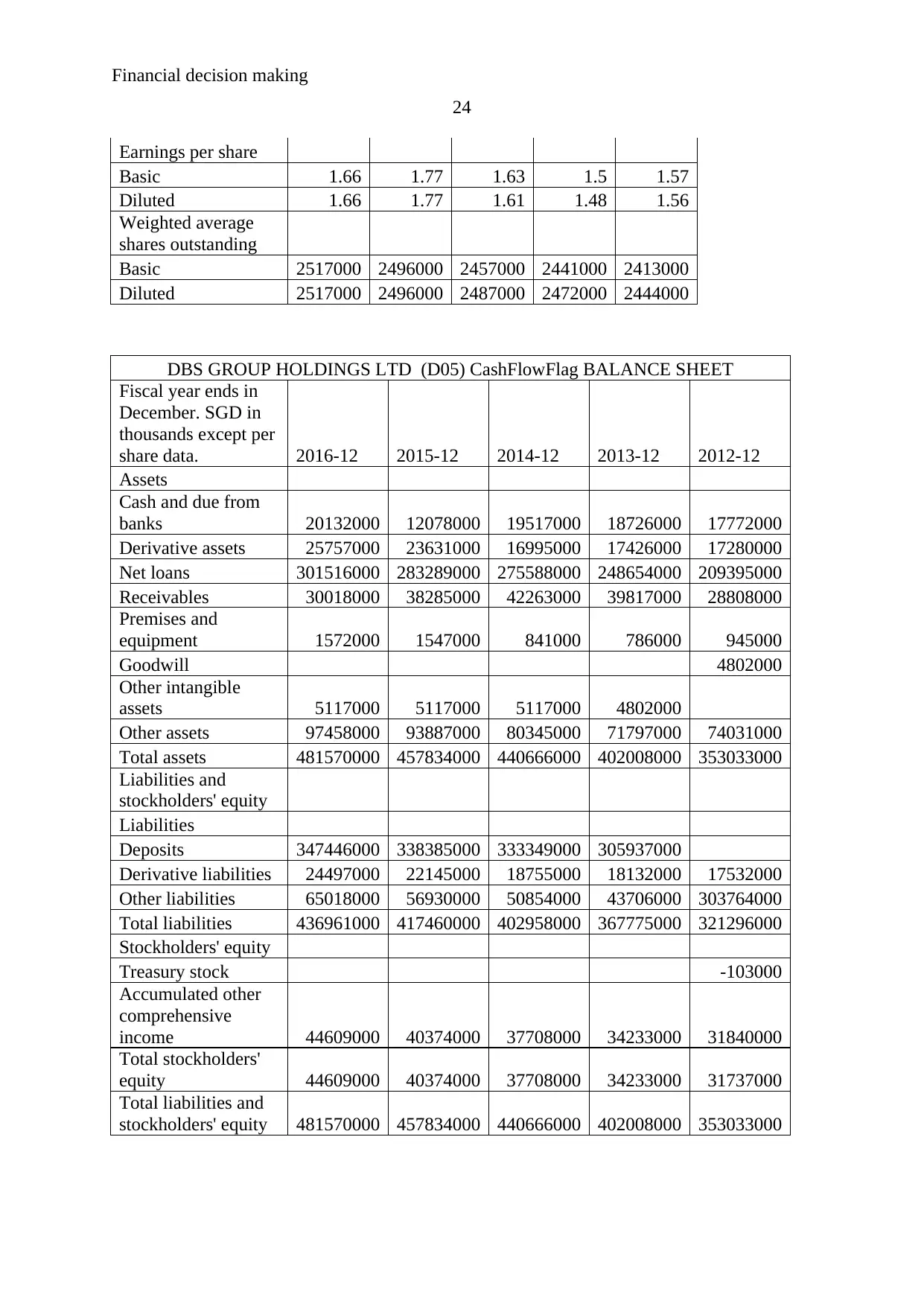
24
Earnings per share
Basic 1.66 1.77 1.63 1.5 1.57
Diluted 1.66 1.77 1.61 1.48 1.56
Weighted average
shares outstanding
Basic 2517000 2496000 2457000 2441000 2413000
Diluted 2517000 2496000 2487000 2472000 2444000
DBS GROUP HOLDINGS LTD (D05) CashFlowFlag BALANCE SHEET
Fiscal year ends in
December. SGD in
thousands except per
share data. 2016-12 2015-12 2014-12 2013-12 2012-12
Assets
Cash and due from
banks 20132000 12078000 19517000 18726000 17772000
Derivative assets 25757000 23631000 16995000 17426000 17280000
Net loans 301516000 283289000 275588000 248654000 209395000
Receivables 30018000 38285000 42263000 39817000 28808000
Premises and
equipment 1572000 1547000 841000 786000 945000
Goodwill 4802000
Other intangible
assets 5117000 5117000 5117000 4802000
Other assets 97458000 93887000 80345000 71797000 74031000
Total assets 481570000 457834000 440666000 402008000 353033000
Liabilities and
stockholders' equity
Liabilities
Deposits 347446000 338385000 333349000 305937000
Derivative liabilities 24497000 22145000 18755000 18132000 17532000
Other liabilities 65018000 56930000 50854000 43706000 303764000
Total liabilities 436961000 417460000 402958000 367775000 321296000
Stockholders' equity
Treasury stock -103000
Accumulated other
comprehensive
income 44609000 40374000 37708000 34233000 31840000
Total stockholders'
equity 44609000 40374000 37708000 34233000 31737000
Total liabilities and
stockholders' equity 481570000 457834000 440666000 402008000 353033000
⊘ This is a preview!⊘
Do you want full access?
Subscribe today to unlock all pages.

Trusted by 1+ million students worldwide

25
DBS GROUP HOLDINGS LTD (D05) Statement of CASH FLOW
Paraphrase This Document

26
Fiscal year ends in
December. SGD in
thousands except
per share data. 2016-12 2015-12 2014-12 2013-12 2012-12
Cash Flows From
Operating
Activities
Deferred tax
(benefit) expense 588000
Investments (gains)
losses -330000 -339000 -274000 -276000
(Gains) loss on
disposition of
businesses -223000 -221000
Stock based
compensation 109000 103000 88000 76000
Receivable 8243000 4361000 -3250000
Loans
-
17363000 -4076000
-
27558000
-
38845000
-
15529000
Payables 13345000
Other assets and
liabilities 12688000 -2637000 27008000 35771000 -5055000
Other operating
activities 6090000 5462000 4935000 4788000 2993000
Net cash provided
by operating
activities 9437000 2874000 3976000 1293000 -6908000
Cash Flows From
Investing Activities
Purchases of
investments -150000
Acquisitions and
dispositions 3000 -21000 66000 360000 191000
Property, and
equipments, net -245000 -194000 -208000 -164000 -248000
Other investing
activities 36000 32000 98000 52000 82000
Net cash used for
investing activities -206000 -333000 -44000 248000 25000
Cash Flows From
Financing
Activities
Change in short-
term borrowing 2943000
Long-term debt
issued 630000
Long-term debt
repayment -1586000 -743000 -977000 -2575000
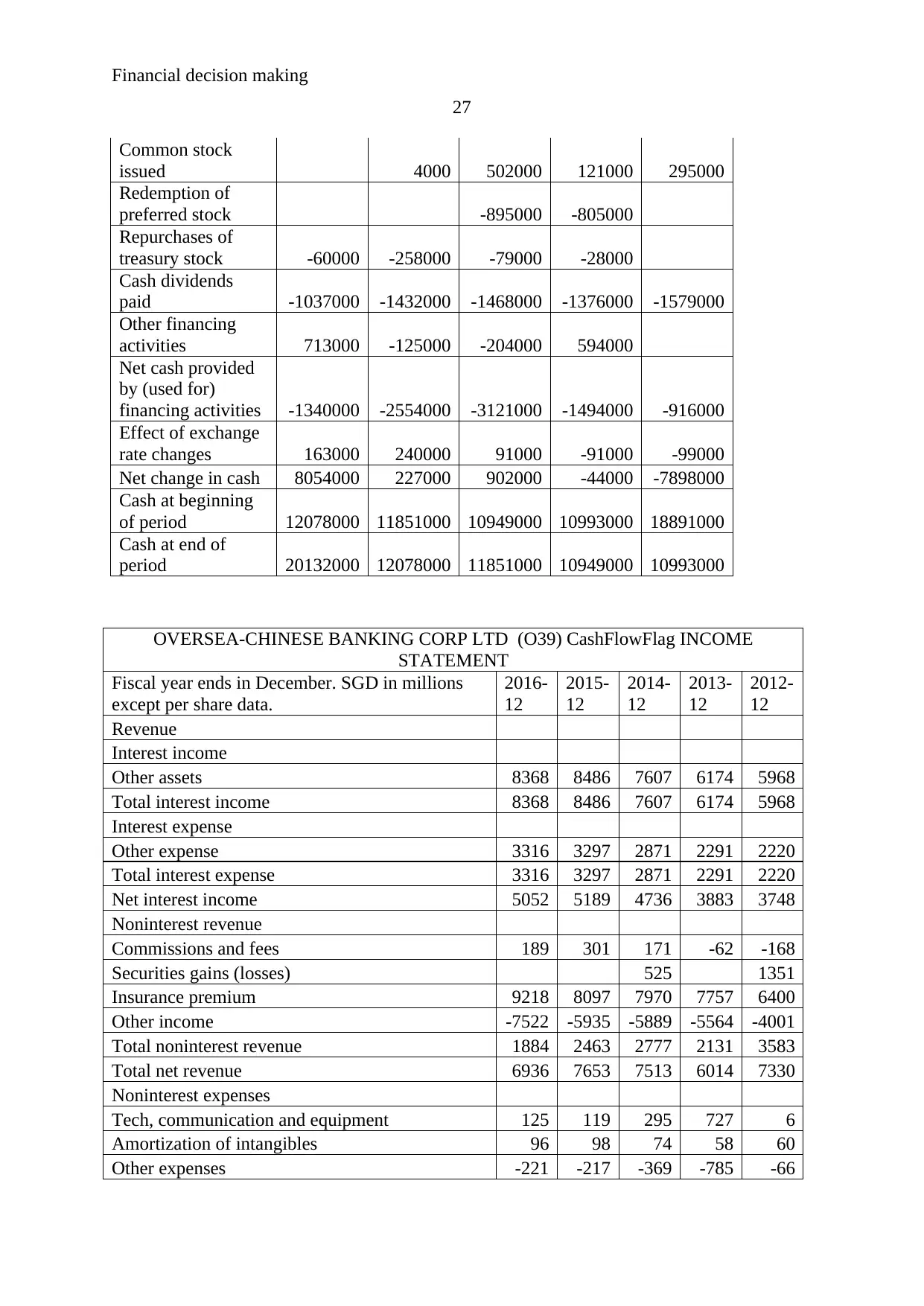
27
Common stock
issued 4000 502000 121000 295000
Redemption of
preferred stock -895000 -805000
Repurchases of
treasury stock -60000 -258000 -79000 -28000
Cash dividends
paid -1037000 -1432000 -1468000 -1376000 -1579000
Other financing
activities 713000 -125000 -204000 594000
Net cash provided
by (used for)
financing activities -1340000 -2554000 -3121000 -1494000 -916000
Effect of exchange
rate changes 163000 240000 91000 -91000 -99000
Net change in cash 8054000 227000 902000 -44000 -7898000
Cash at beginning
of period 12078000 11851000 10949000 10993000 18891000
Cash at end of
period 20132000 12078000 11851000 10949000 10993000
OVERSEA-CHINESE BANKING CORP LTD (O39) CashFlowFlag INCOME
STATEMENT
Fiscal year ends in December. SGD in millions
except per share data.
2016-
12
2015-
12
2014-
12
2013-
12
2012-
12
Revenue
Interest income
Other assets 8368 8486 7607 6174 5968
Total interest income 8368 8486 7607 6174 5968
Interest expense
Other expense 3316 3297 2871 2291 2220
Total interest expense 3316 3297 2871 2291 2220
Net interest income 5052 5189 4736 3883 3748
Noninterest revenue
Commissions and fees 189 301 171 -62 -168
Securities gains (losses) 525 1351
Insurance premium 9218 8097 7970 7757 6400
Other income -7522 -5935 -5889 -5564 -4001
Total noninterest revenue 1884 2463 2777 2131 3583
Total net revenue 6936 7653 7513 6014 7330
Noninterest expenses
Tech, communication and equipment 125 119 295 727 6
Amortization of intangibles 96 98 74 58 60
Other expenses -221 -217 -369 -785 -66
⊘ This is a preview!⊘
Do you want full access?
Subscribe today to unlock all pages.

Trusted by 1+ million students worldwide
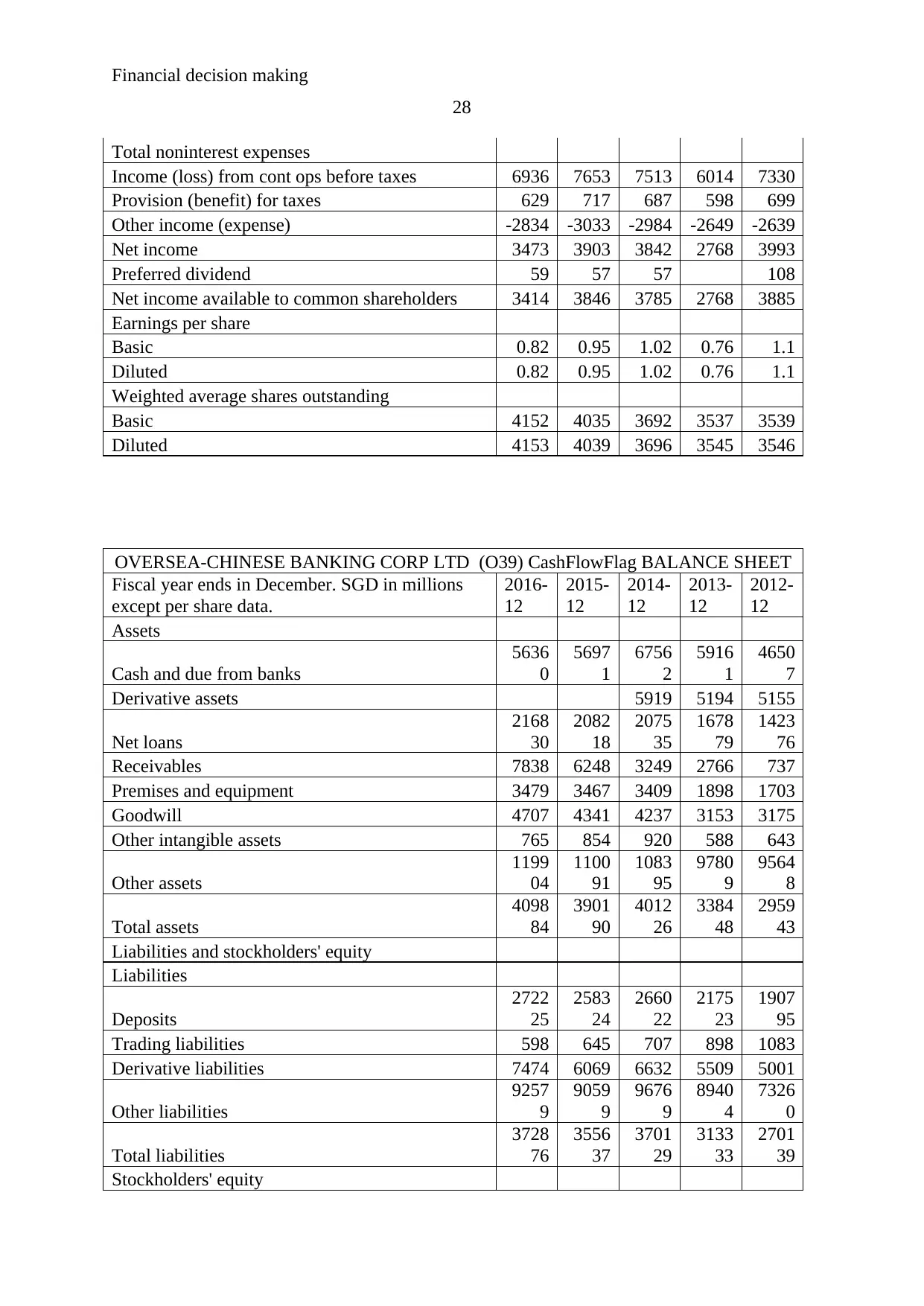
28
Total noninterest expenses
Income (loss) from cont ops before taxes 6936 7653 7513 6014 7330
Provision (benefit) for taxes 629 717 687 598 699
Other income (expense) -2834 -3033 -2984 -2649 -2639
Net income 3473 3903 3842 2768 3993
Preferred dividend 59 57 57 108
Net income available to common shareholders 3414 3846 3785 2768 3885
Earnings per share
Basic 0.82 0.95 1.02 0.76 1.1
Diluted 0.82 0.95 1.02 0.76 1.1
Weighted average shares outstanding
Basic 4152 4035 3692 3537 3539
Diluted 4153 4039 3696 3545 3546
OVERSEA-CHINESE BANKING CORP LTD (O39) CashFlowFlag BALANCE SHEET
Fiscal year ends in December. SGD in millions
except per share data.
2016-
12
2015-
12
2014-
12
2013-
12
2012-
12
Assets
Cash and due from banks
5636
0
5697
1
6756
2
5916
1
4650
7
Derivative assets 5919 5194 5155
Net loans
2168
30
2082
18
2075
35
1678
79
1423
76
Receivables 7838 6248 3249 2766 737
Premises and equipment 3479 3467 3409 1898 1703
Goodwill 4707 4341 4237 3153 3175
Other intangible assets 765 854 920 588 643
Other assets
1199
04
1100
91
1083
95
9780
9
9564
8
Total assets
4098
84
3901
90
4012
26
3384
48
2959
43
Liabilities and stockholders' equity
Liabilities
Deposits
2722
25
2583
24
2660
22
2175
23
1907
95
Trading liabilities 598 645 707 898 1083
Derivative liabilities 7474 6069 6632 5509 5001
Other liabilities
9257
9
9059
9
9676
9
8940
4
7326
0
Total liabilities
3728
76
3556
37
3701
29
3133
33
2701
39
Stockholders' equity
Paraphrase This Document
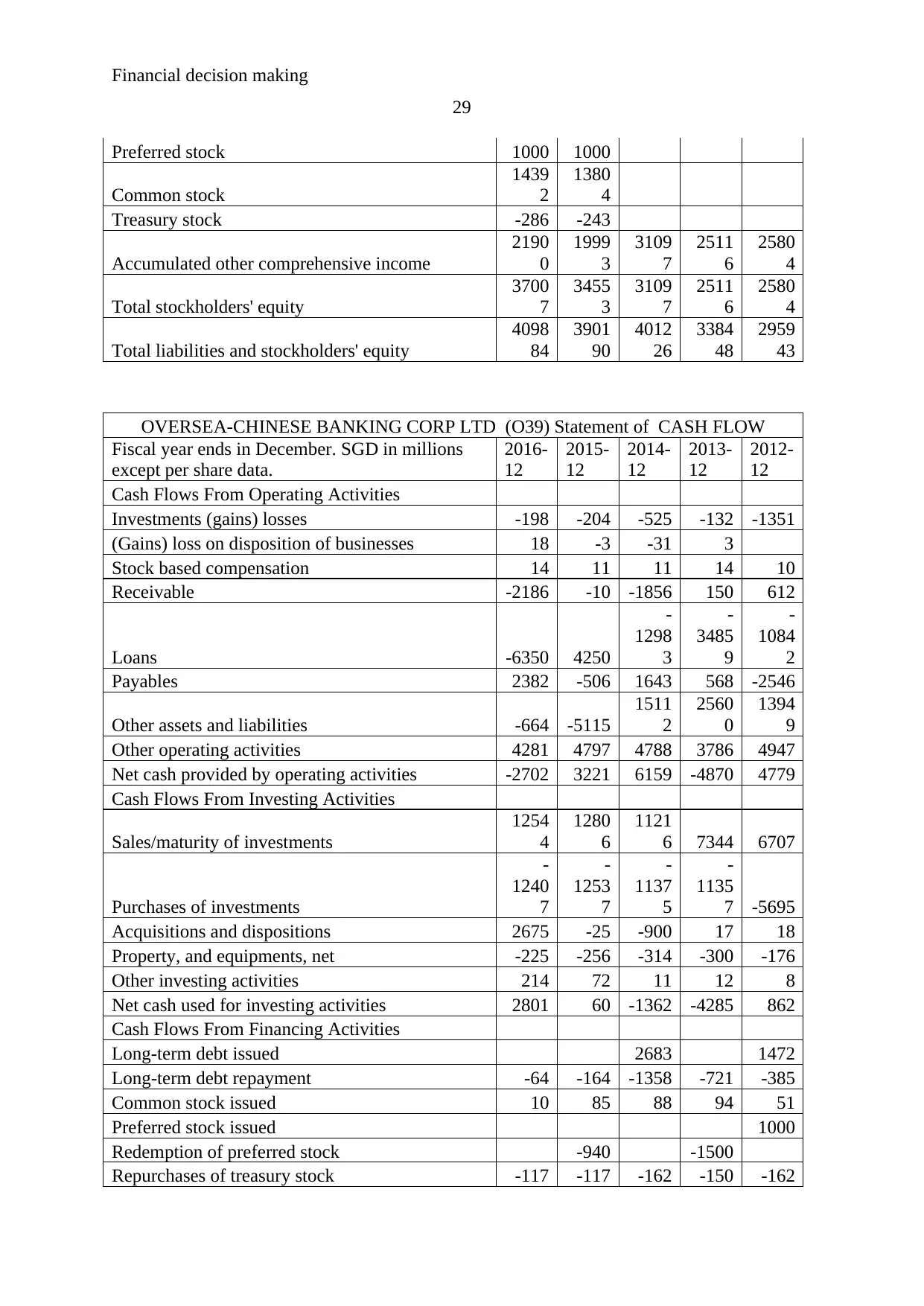
29
Preferred stock 1000 1000
Common stock
1439
2
1380
4
Treasury stock -286 -243
Accumulated other comprehensive income
2190
0
1999
3
3109
7
2511
6
2580
4
Total stockholders' equity
3700
7
3455
3
3109
7
2511
6
2580
4
Total liabilities and stockholders' equity
4098
84
3901
90
4012
26
3384
48
2959
43
OVERSEA-CHINESE BANKING CORP LTD (O39) Statement of CASH FLOW
Fiscal year ends in December. SGD in millions
except per share data.
2016-
12
2015-
12
2014-
12
2013-
12
2012-
12
Cash Flows From Operating Activities
Investments (gains) losses -198 -204 -525 -132 -1351
(Gains) loss on disposition of businesses 18 -3 -31 3
Stock based compensation 14 11 11 14 10
Receivable -2186 -10 -1856 150 612
Loans -6350 4250
-
1298
3
-
3485
9
-
1084
2
Payables 2382 -506 1643 568 -2546
Other assets and liabilities -664 -5115
1511
2
2560
0
1394
9
Other operating activities 4281 4797 4788 3786 4947
Net cash provided by operating activities -2702 3221 6159 -4870 4779
Cash Flows From Investing Activities
Sales/maturity of investments
1254
4
1280
6
1121
6 7344 6707
Purchases of investments
-
1240
7
-
1253
7
-
1137
5
-
1135
7 -5695
Acquisitions and dispositions 2675 -25 -900 17 18
Property, and equipments, net -225 -256 -314 -300 -176
Other investing activities 214 72 11 12 8
Net cash used for investing activities 2801 60 -1362 -4285 862
Cash Flows From Financing Activities
Long-term debt issued 2683 1472
Long-term debt repayment -64 -164 -1358 -721 -385
Common stock issued 10 85 88 94 51
Preferred stock issued 1000
Redemption of preferred stock -940 -1500
Repurchases of treasury stock -117 -117 -162 -150 -162
Related Documents
Your All-in-One AI-Powered Toolkit for Academic Success.
+13062052269
info@desklib.com
Available 24*7 on WhatsApp / Email
![[object Object]](/_next/static/media/star-bottom.7253800d.svg)
© 2024 | Zucol Services PVT LTD | All rights reserved.





